Niwalker Vostro BK-FA01 (XM-L2) BK-FA02 (MT-G2) 4x18650 Pre-release Review: BEAMS+
Warning: even more pic heavy than usual.
UPDATE JULY 23, 2013: This pre-release review has been superseded by my new review of the shipping versions of these lights. Please continue all conversations in that thread, thanks!
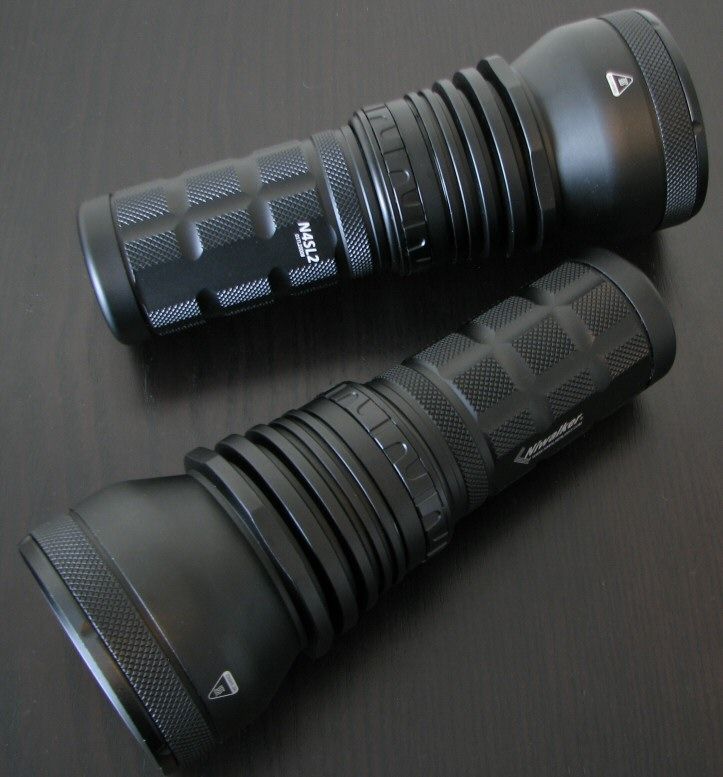
Welcome to my review of a couple of new high-output lights from Niwalker, the recently re-christened Black Light Vostro series. This series is available with either a throwy Cree XM-L2 U2, or high-output Cree MT-G2.
Model numbers are bit complicated for this series – in keeping with past Niwalker releases, I have had the opportunity to test a variety of engineering samples. Originally known as the NWK1000 series, the final pre-release samples (tested here) were known as the N4SL2 (XM-L2 U2) and N4SG2 (MT-G2), as labelled above. Niwalker plans to rename these as part of a new Black Light series (model name: Vostro). The two specific lights will be known as the BK-FA01 (XM-L2 U2) and BK-FA02 (MT-G2). Note that these were briefly referred to as "BK1" and "BK2", but I am assured by Niwalker that the BK-FA01 and BK-FA02 numbering scheme will be the final one.
As an aside, this will be my first review of a high-output light with the new Cree MT-G2 emitter. Relatively unknown in the flashlight world, the MT-G2 "Easywhite" series was designed for higher voltage, high-output directional lighting applications (i.e., as a replacement for classic halogen bulbs in accent lighting, track lights, etc.). I'll discuss the pattern of this emitter class a little later on, but I expect we will be seeing a few more lights using it in the near future, as an alternative to smaller Luminus emitters ...
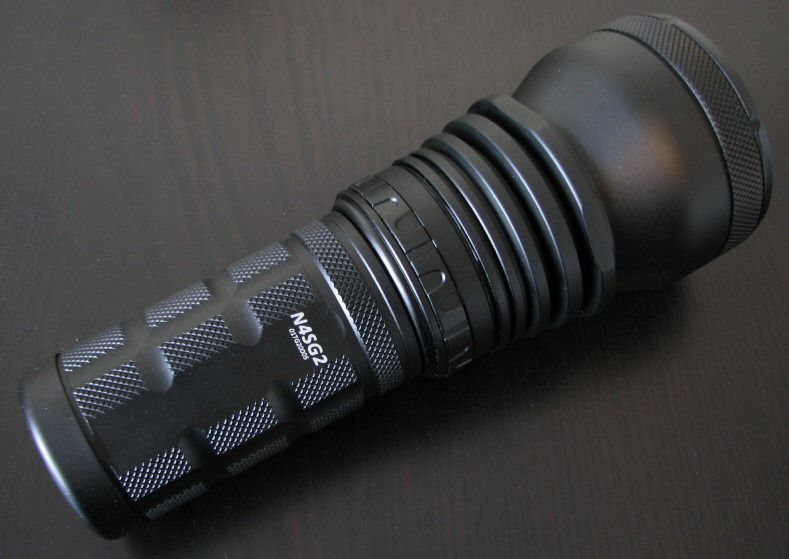
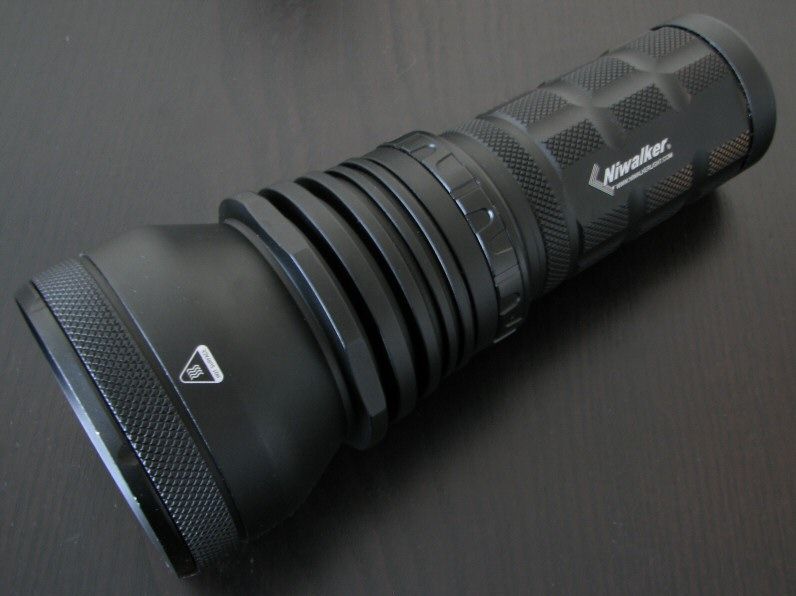
At the moment, I have very limited specs from Niwalker on this series, but here's what I do have:
Manufacturer Reported Specifications:
(note: as always, these are simply what the manufacturer provides – scroll down to see my actual testing results).

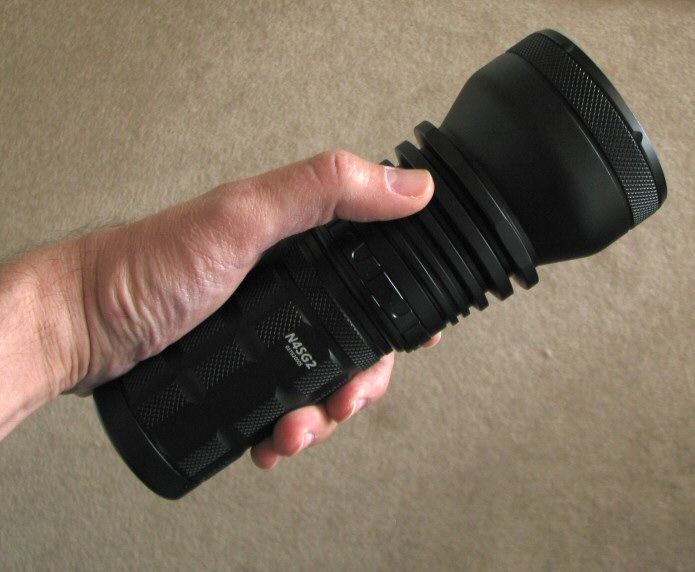
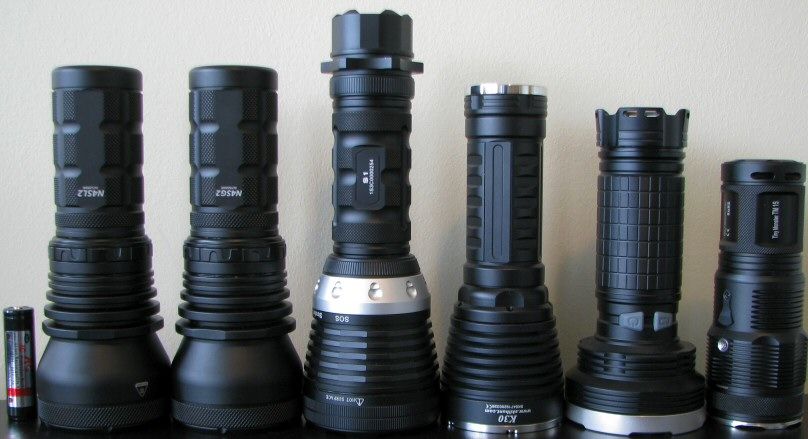
From left to right: AW Protected 18650; Niwalker Black Light Vostro BK-FA01, BK-FA02; Xtar S1; Skilhunt K30; Fenix TK75; Nitecore TM15.
All dimensions directly measured, and given with no batteries installed (unless indicated):
Niwalker Black Light BK-FA01: Weight: 687g (871g with 4x18650), Length: 208mm, Width (bezel): 80.0mm, Width (tailcap): 51.9mm
Niwalker Black Light BK-FA02: Weight: 689g (873g with 4x18650), Length: 208mm, Width (bezel): 80.0mm, Width (tailcap): 51.9mm
Eagletac MX25L2:Weight: 468.7g (with battery pack: 744.2g), Length: 266mm, Width (bezel): 62.0mm
Foursevens S18: Weight: 700g (800g with 6xCR123A), Length: 233mm, Width (bezel) 63.0mm
Fenix TK75: Weight: 516.0g (700g with 4x18650), Length: 184mm, Width (bezel): 87.5mm
Olight SR95: Weight: 1,224g (with battery pack), Length: 323mm, Width (bezel): 87mm
Skilhunt K30: Weight: 636.0g (773g with 3x18650), Length: 199m, Width (bezel): 76.0mm
Thrunite TN31: Weight: 572g (est 724g with 3x18650), Length: 203mm, Width (bezel): 79.0mm, Width (tailcap): 49.0mm
Xtar S1 Production: Weight: 876.0g (est. 1028g with 3x18650 protected), Length: 240mm, Width (bezel): 83.4mm
The BK-FA0x series has a substantial form factor, in keeping with other 3x and 4x18650 lights in this space.
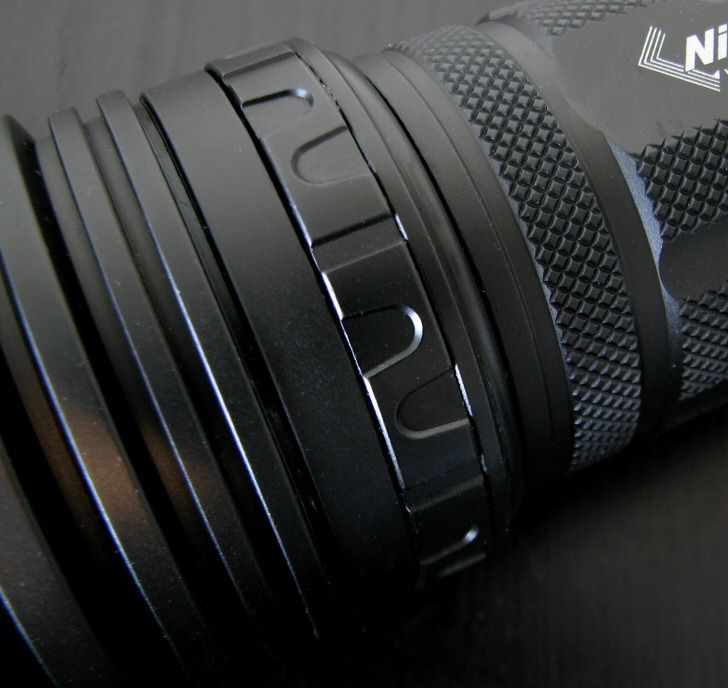
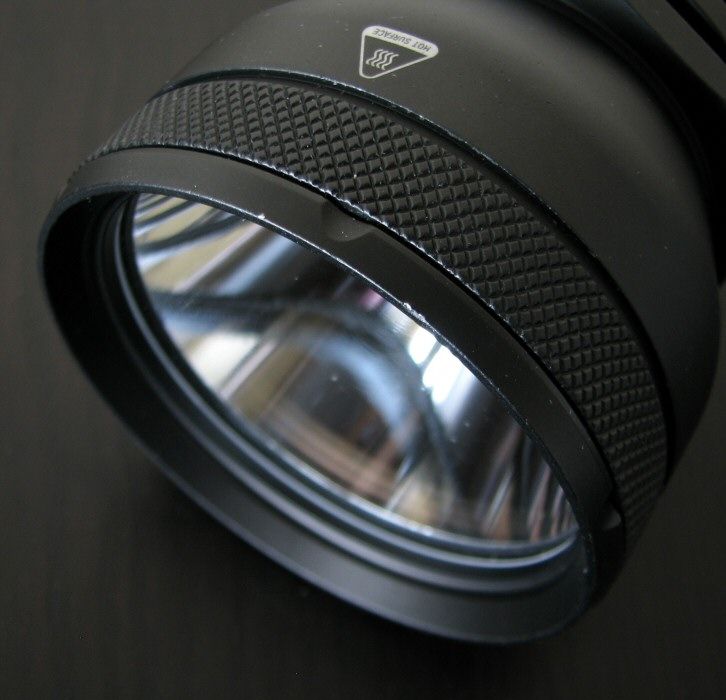
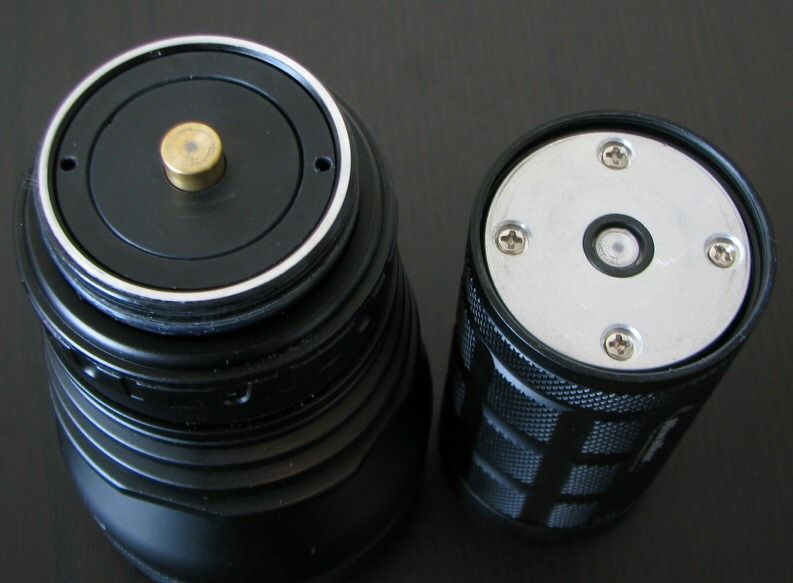
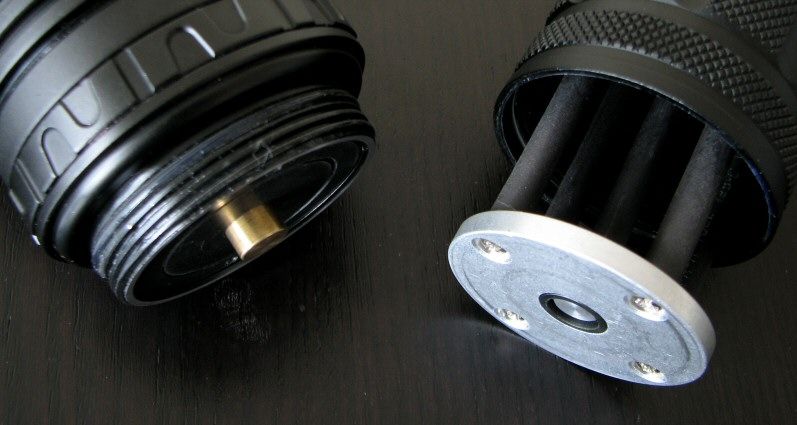
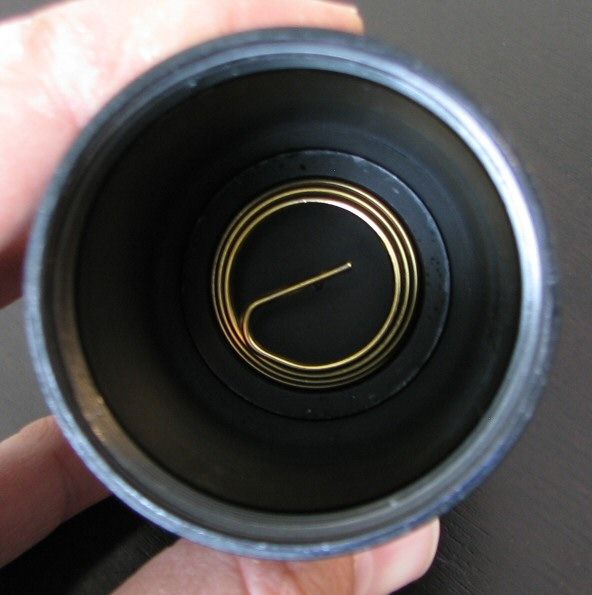
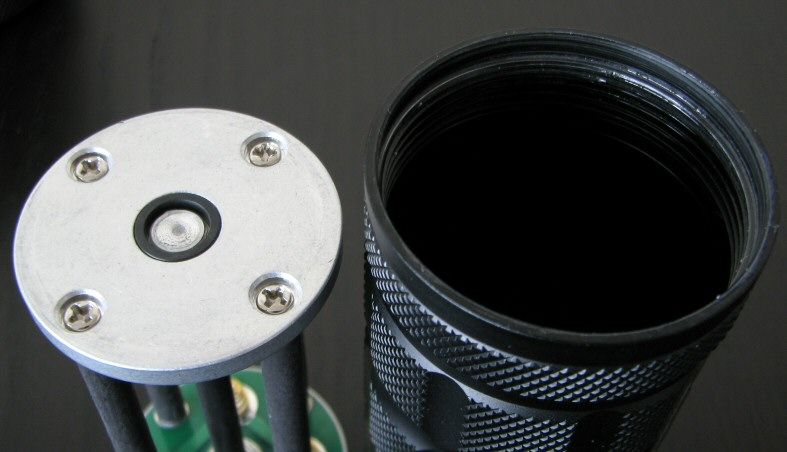
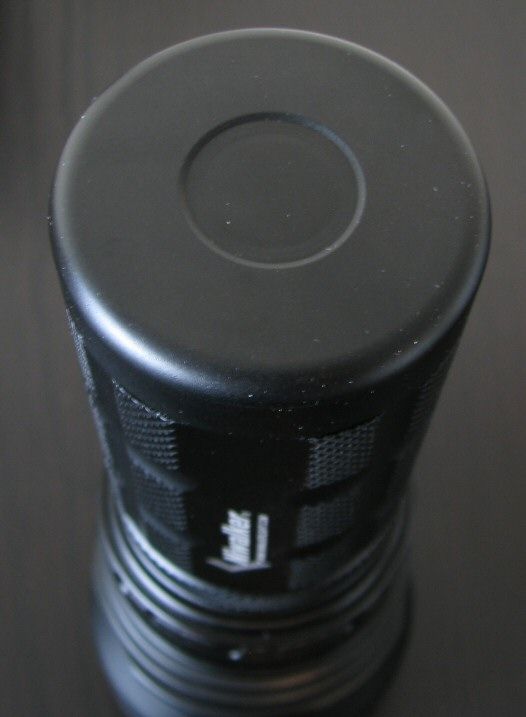
Keep in mind that my samples are the last round of engineering samples, and things could potentially still change when the shipping versions roll out. The most obvious change should be in the body labels – the N4SL2 and N4SG2 will be renamed BK-FA01 and BK-FA02, according to Niwalker.
Both my samples came with serial numbers, and all lettering was bright white and clear against the dark background. The lights come in a matte black finish. There were a few chips in some locations on my samples, but that may just reflect their engineering sample status (i.e., they underwent specific testing before being sent to me, and had the chance to get banged up a bit).
As mentioned earlier, over size is substantial. They remind me of the Thrunite TN31 in rough dimensions, but the battery handle is of course slightly wider to accommodate four cells instead of three (with concomitant weight increase). Like the TN31, there is knurling on the body handle to help with grip, and some ridge detail on the head and ring. Grip is certainly ok, and comparable to the TN31.
One difference is that I find the control ring to be a bit "stiffer" overall than on the TN31. Both my BK-series had more resistance to turning, which could make changing modes single-hand tougher for those without decent grip strength. Note the control ring is much narrower than the TN31, contributing to this challenge (i.e., there is less for your fingers to grip onto). :shrug: But like the TN31, there are firm and clear detents for each level (see User Interface for a discussion of the modes).
The lights can tailstand stably, thanks to the flat base.
Screw threads are anodized for head lock out, and feature square-cut (trapezoidal) threads. :thumbsup:
There is a central contact point in the center of the head of the light, which has a spring underneath. This makes contact with the recessed inner positive terminal of the battery carrier. The negative current path is carried from the outside part of the battery carrier, carried through a spring in the tailcap through the body of the light.
Battery carrier:
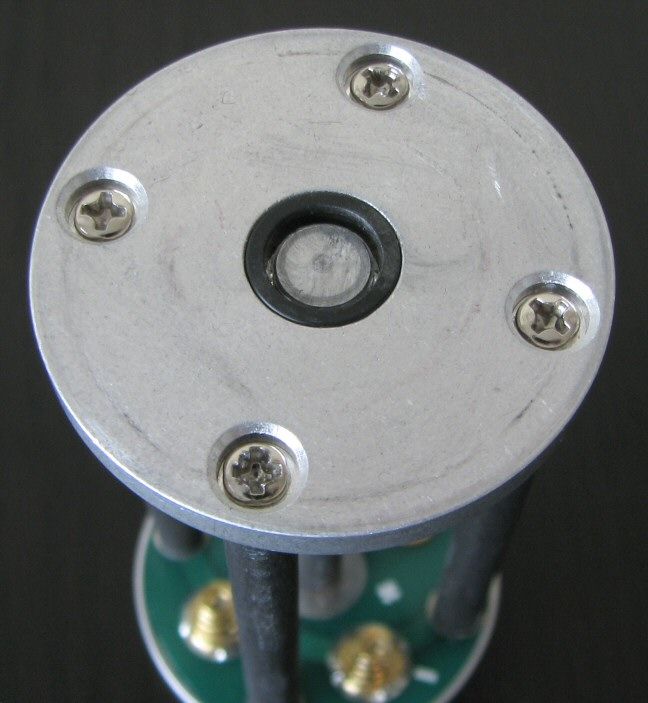
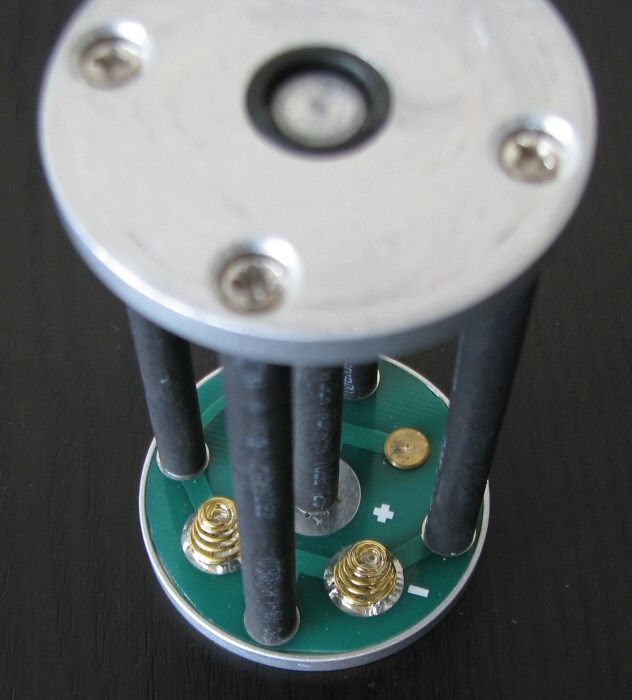
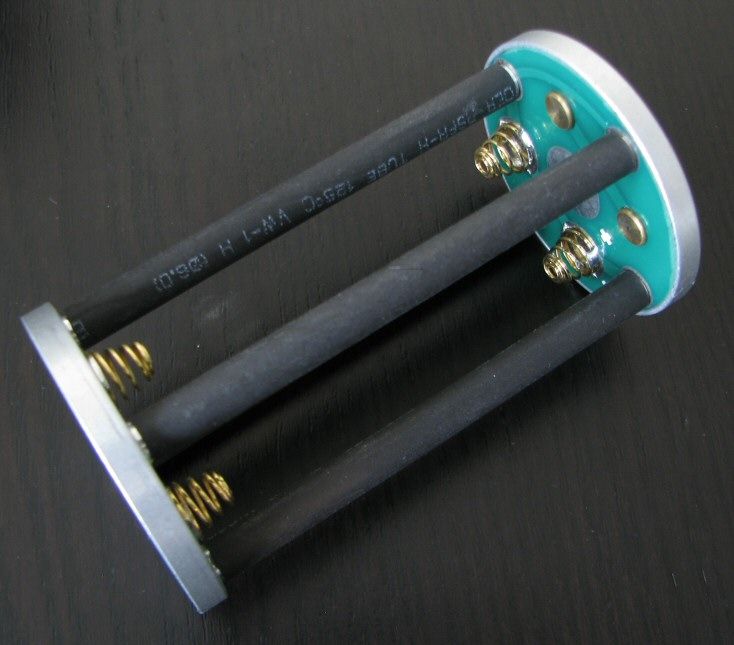

The carrier has a very solid feel, with thick end plates and sturdy struts. The carrier has a 2s2p arrangement (i.e., two cells in parallel, two channels in series). This means in theory that you could run the light on just two cells if necessary, but I wouldn't recommend this on the higher output modes (unless using IMR chemistry which can handle the higher current drain). The carriers are reversible – they fit and work in the light in either orientation.
Often, on other lights, I find battery carriers to be a tight fit for cells, not allowing really long or wide cells into the carrier/light (a particular issue for the newer high capacity cells on the market). Some also have physical reverse polarity protectors around the positive terminals (preventing use of flat-top cells). I'm happy to report the BK-series carrier has plenty of room for everything I own, and the raised positive contact posts work with all cell types (including flat-tops). :thumbsup:
Let's see how the business ends of the lights differ:
BK-FA01 head:
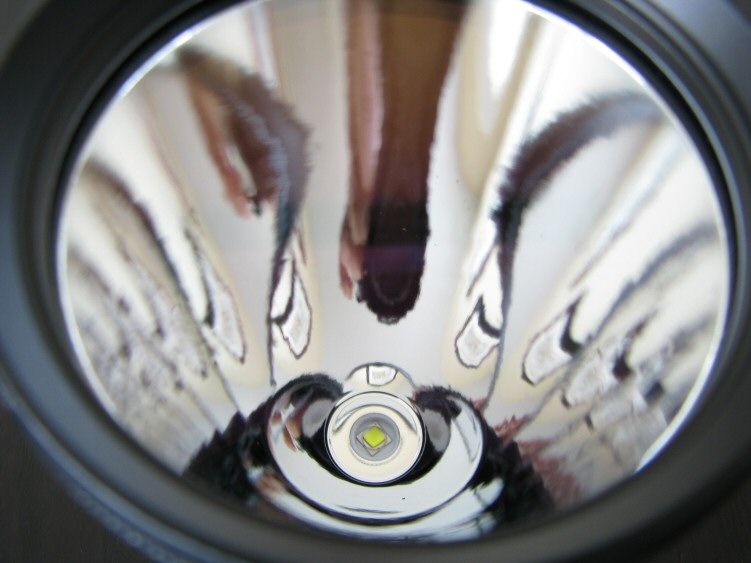
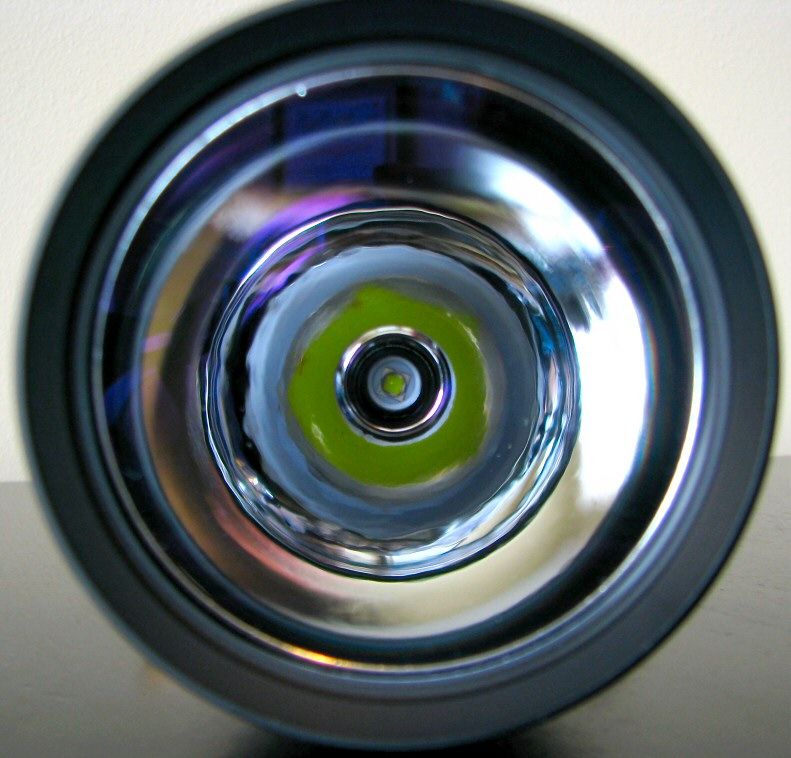
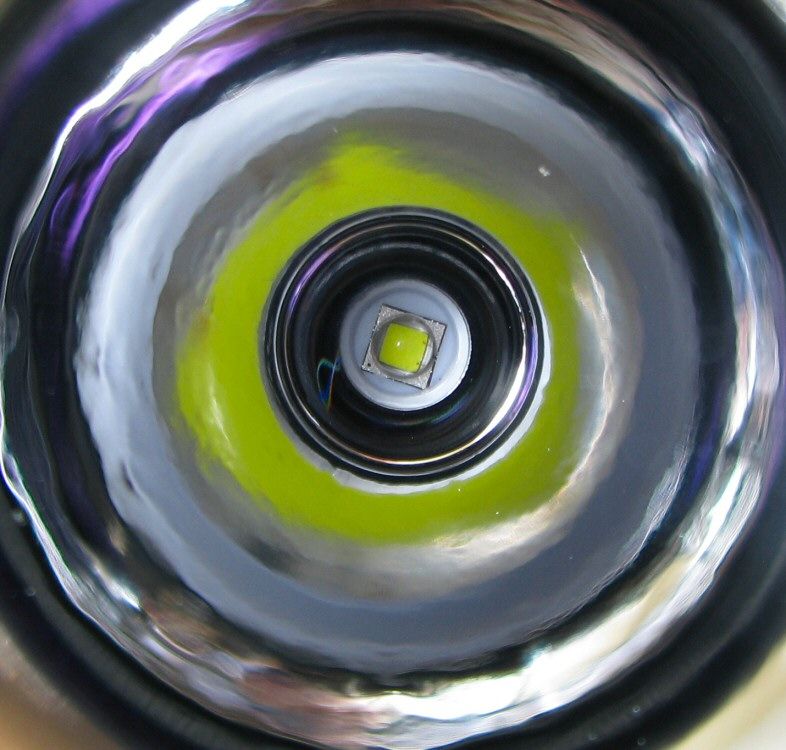
BK-FA02 head:
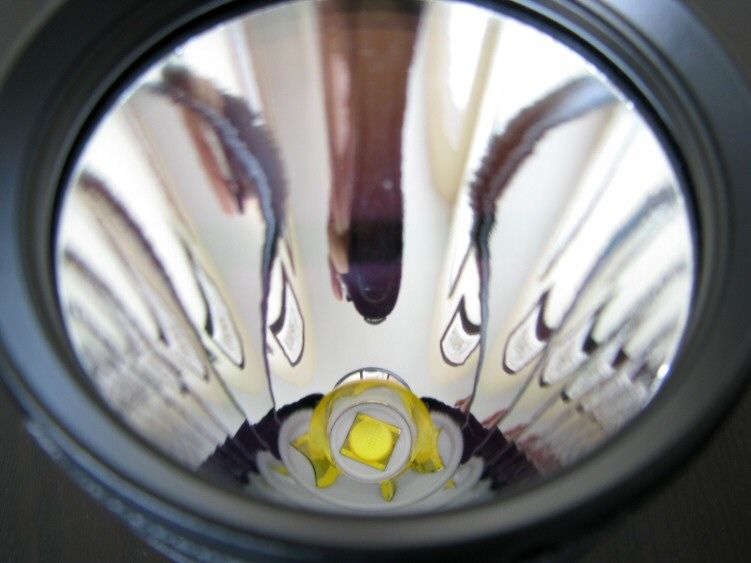
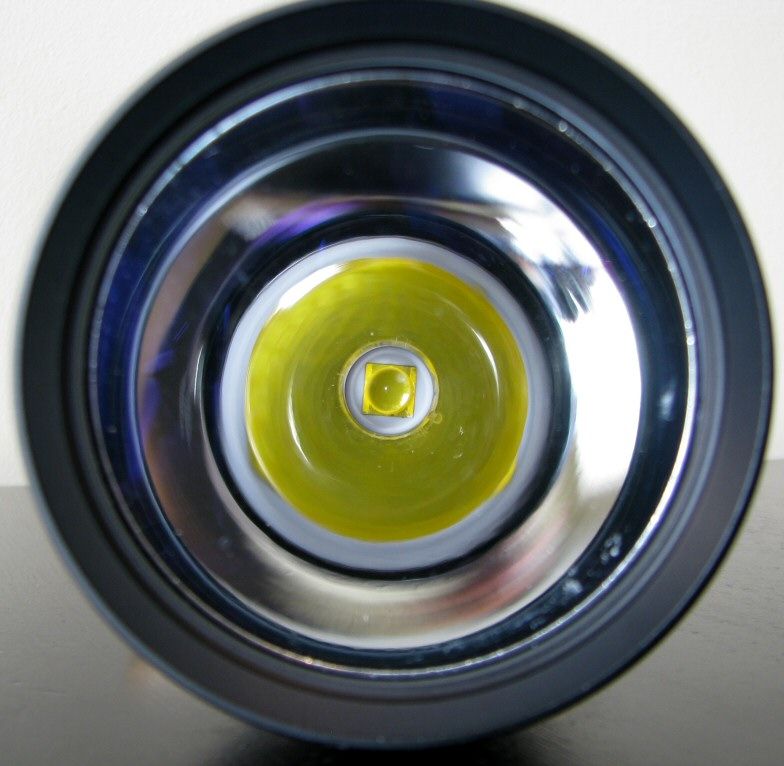
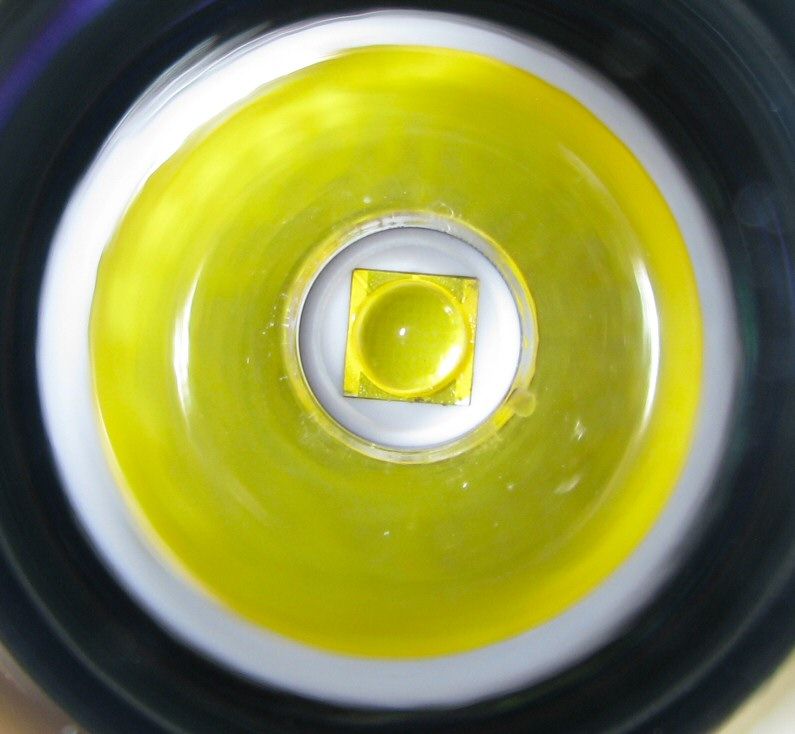
Clearly, the BK-series is using a large reflector – it's one of the deepest ones I've seen, in fact. oo: Overall dimensions and appearance are again very similar to the Thrunite TN31, but the BK-FA01 is actually slightly deeper. For an equivalent drive level, I expect it should have at least as good (if not better) throw than the XM-L2 version of the TN31. For the BK-FA02, there's a slight difference in the opening at the base of the reflector, but overall dimensions seem otherwise comparable.
oo: Overall dimensions and appearance are again very similar to the Thrunite TN31, but the BK-FA01 is actually slightly deeper. For an equivalent drive level, I expect it should have at least as good (if not better) throw than the XM-L2 version of the TN31. For the BK-FA02, there's a slight difference in the opening at the base of the reflector, but overall dimensions seem otherwise comparable.
In both cases, the emitters were well centered in their reflectors. The XM-L2 emitter is probably already very familiar to the members here, but the MT-G2 is an interesting choice to find in a flashlight. According the Cree MT-G2 spec sheet, the emphasis for this series is "down lighting applications where color quality, consistency and optical control are required."
As you can tell, the MT-G2 is a remarkably large emitter, with a dome diameter of almost 8.9mm (vs. 5mm on the XM-L2). Of course, what really matters is the surface area of the die underneath, which is only 2x2mm on the XM-L2. I am not sure of the actual die dimensions on the MT-G2, but as you will see in the blow-up pics below (same magnification), there appears to be a grid of 72 distinct segments.
XM-L2:
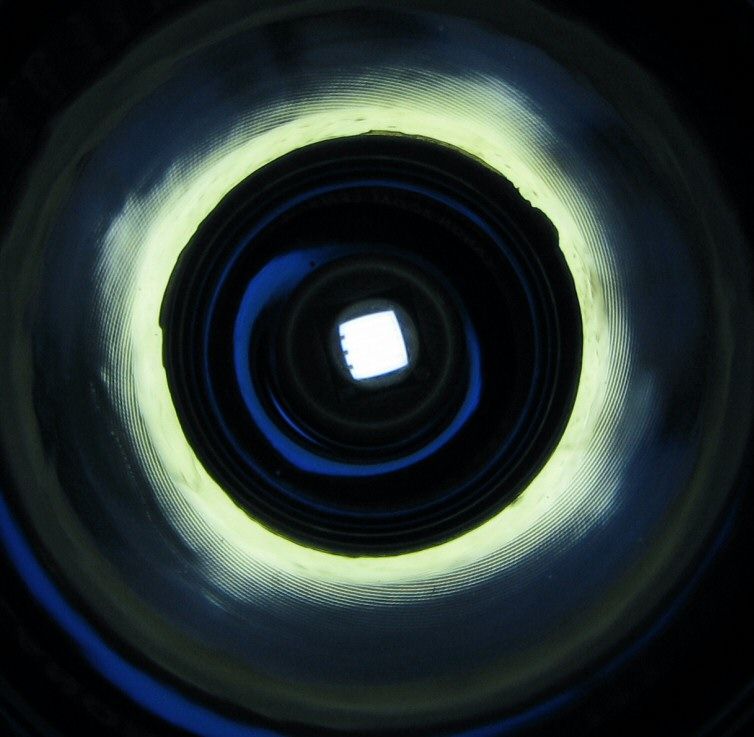
MT-G2:
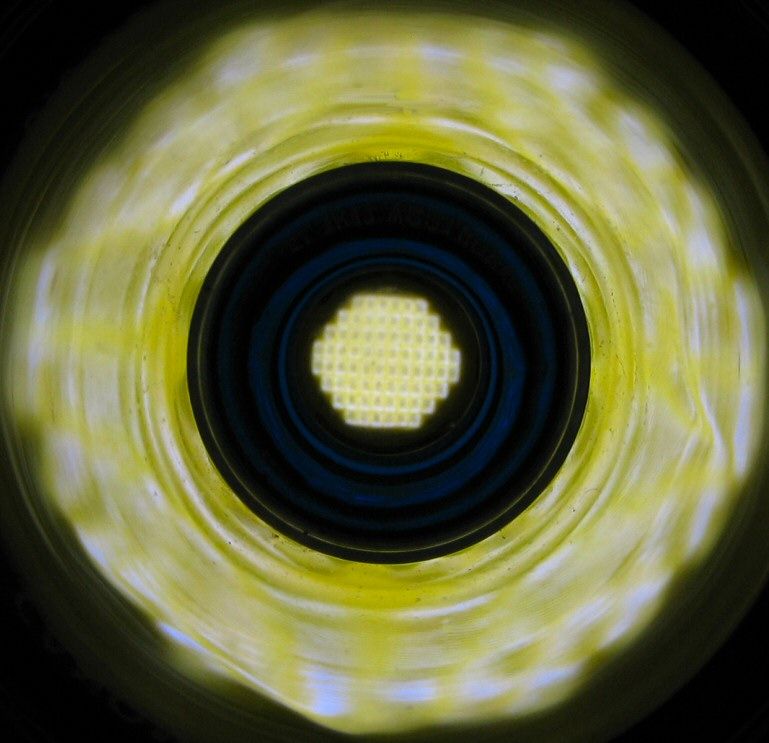
The result of this will be reduced throw for a given output level, compared to even the relatively large Luminus SST-90. The MT-G2 is also an unusual choice for a flashlight as it runs at much higher forward voltages (6V, 9V or 36V, depending on the model), compared to the <3V typical flashlight LED. All told, the MT-G2 is something I would expect to see in a LED replacement bulb for a standard PAR20 halogen pot light, or BR30 halogen flood light, for example.
The MT-G2 also comes in a wide variety of relatively warm defined tint bins – 2700K, 3000K, 3500K, 4000K, and 5000K color temperature – with a minimum CRI of 70-75, depending on the tint bin. Cree also offers higher 80 CRI at the cooler end of the tint bins, and guaranteed 90 CRI at the warmer end of the tint bins (presumably for increased cost).
I don't know if a defined tint bin is used in the BK-FA02, but Niwalker reports this model to be "Neutral White". That is consistent with the samples I've tested, which I would consider to be around the middle of the above range offered by Cree.
User Interface
The BK-series lights use a magnetic control ring, very similar in function to the Thrnunite TN30/31. But as previously mentioned, the ring has a narrower height on the BK-series, and my two samples both show higher resistance to turning. Like the TN30/31, the ring does have pronounced detents at each position (i.e., you can feel when the light "locks" into position for a given mode).
You turn on or change output modes by turning the control ring. Arranged from left-to-right (looking down at the light, held in traditional forward flashlight carry), the modes are: Strobe > Standby Off > Level 1 > Level 2 > Level 3 > Level 4 > Level 5 > Level 6 (max). See my testing results later in this review for the relative output mode spacing.
I've seen similar spacings on small hand-held lights (i.e., Strobe being located to the left of Standby/Off). But most manufacturers tend to put any blinky modes at the end of the sequence, by the highest output.
No light is produced on Standby/Off, but a small current will be drawn to allow the circuit to respond to a ring turn (see below). As always, I recommend you store such lights locked-out by a head twist.
Video:
For more information on the overall build and user interface of the BK-series, please see my video overview:
Videos were recorded in 720p, but YouTube typically defaults to 360p. Once the video is running, you can click on the configuration settings icon and select the higher 480p to 720p options. You can also run full-screen.
As with all my videos, I recommend you have annotations turned on. I commonly update the commentary with additional information or clarifications before publicly releasing the video.
PWM/Strobe
The BK-FA01 and BK-FA02 show completely identical circuit patterns at all levels. The lights appear to use high-frequency PWM that is not visible to the eye: 2.45 kHz.
However, it is a little more complicated than that. At the three lowest levels, the lights have a re-occurring signal at this 2.45 kHz frequency – but without the typical PWM pattern, as shown below.
Level 1
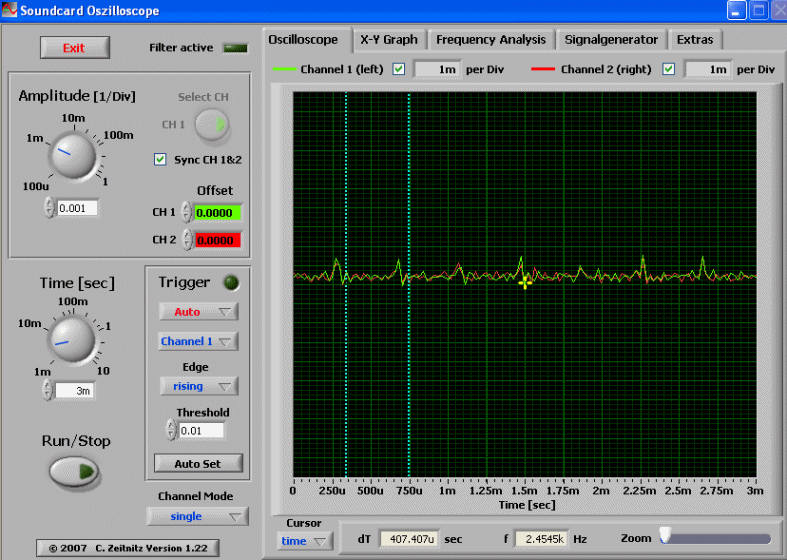
Level 2
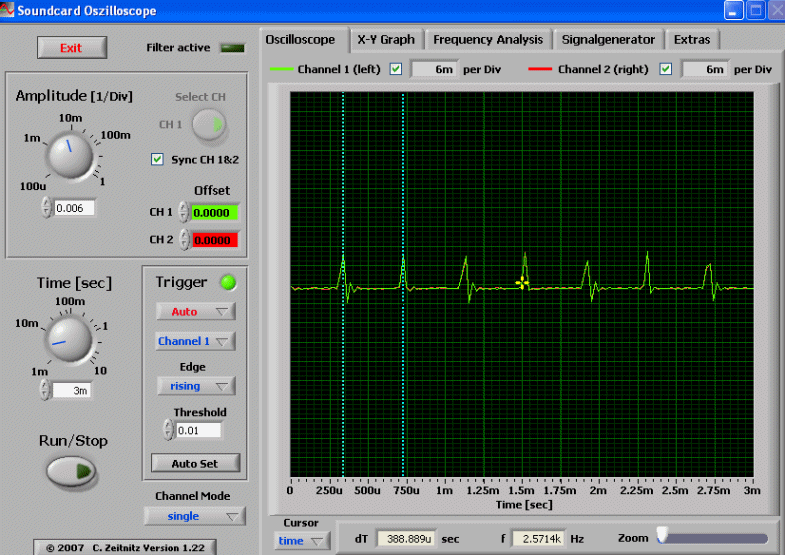
Level 3
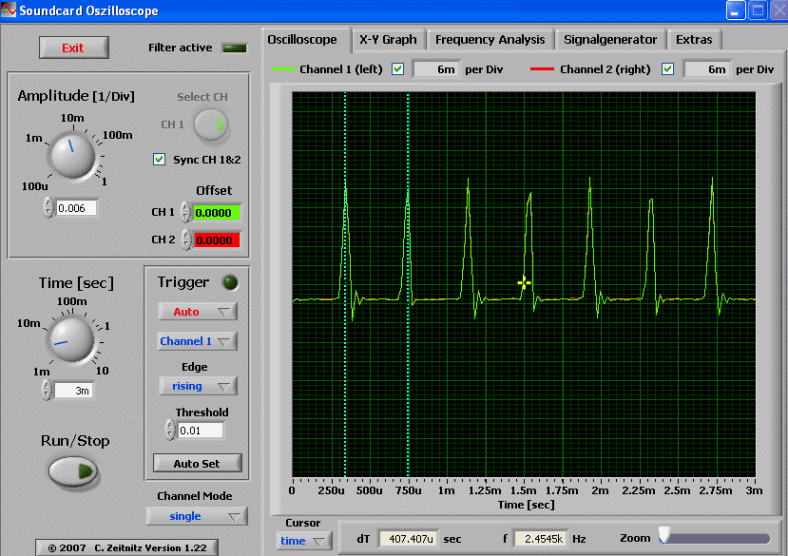
As you can see above, you just get a simple spike at this frequency on these three lowest levels. The intensity of the signal seems directly proportional to the output level, and there is no sign of the classic PWM pattern (i.e., the on-phase should be getting longer as you go up in output). On the basis of this result, I would think these levels are current-controlled, but with a recurrent 2.45kHz signal.
In contrast, the next two levels clearly show a typical PWM profile, at the same frequency:
Level 4
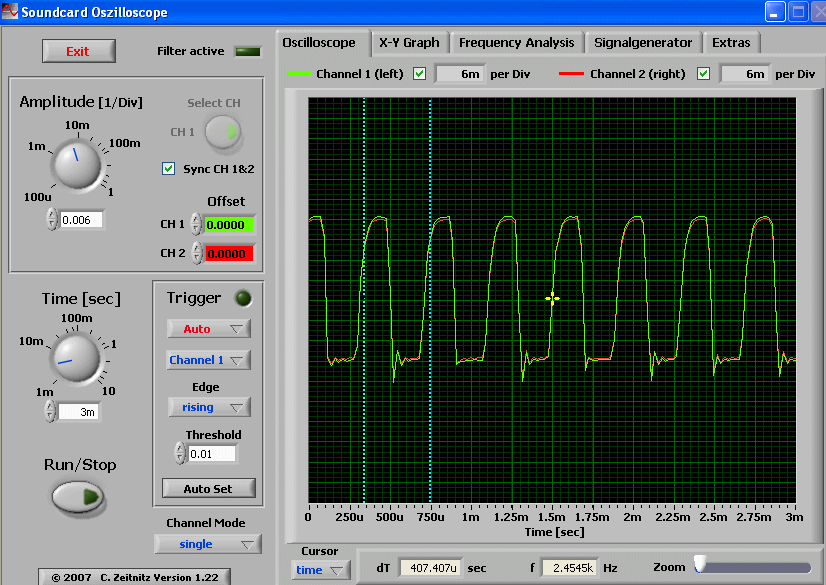
Level 5

Here you can see the typical PWM pattern – at Level 4, the light is on ~45% of the time, and level 5 the light is on ~80% of the time. This is exactly what you would expect, based on my estimated output measures (see later in the review).
Note that at Level 6, there is no signal at all – the light is at full uninterrupted power.
Based on these findings, I would tentatively conclude that these lights use PWM for L4 and L5 (and maybe L3), but are in fact current-controlled at L1 and L2 (and maybe L3) with a recurrent signal.
Strobe
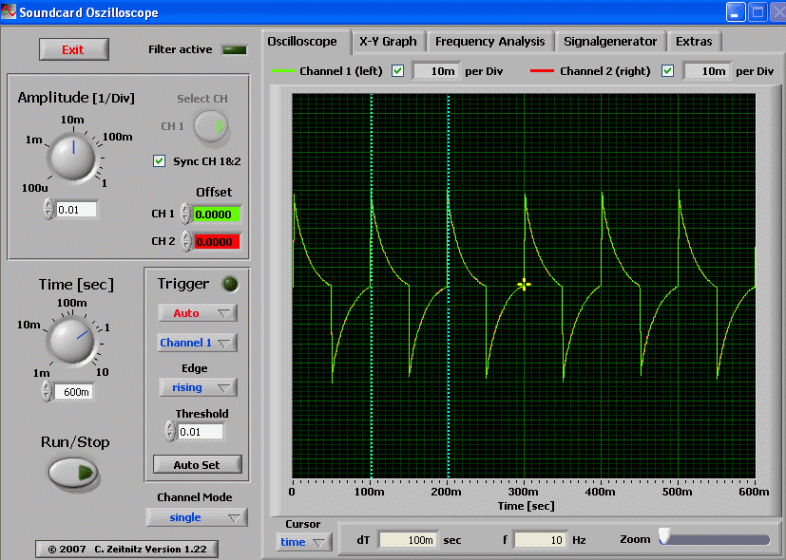
Strobe is a consistent 10Hz in my testing, on both lights.
Standby Drain
Due to the electronic control ring, the BK-series lights will always be drawing a current when the body/carrier is connected to the head. On the BK-FA01 I measured this current as 525uA, and on the BK-FA02 I measured it as 520uA.
Assuming 4x 2600mAh capacity batteries in the 2s2p arrangement (i.e., 5200mAh effective capacity), that would give you ~415 days for each of the lights (or just under 14 months). This is not unreasonable for this type of light, but I do recommend you store the lights with the head locked out when not in use. This just requires a quick turn from fully tight, as the screw threads are anodized for lock out.
Beamshots:
And now, what you have all been waiting for. All lights are on their standard battery, or AW protected 18650 2200mAh for the multi-18650 lights. Lights are about ~0.75 meter from a white wall (with the camera ~1.25 meters back from the wall). Automatic white balance on the camera, to minimize tint differences.
All lights are on their standard battery, or AW protected 18650 2200mAh for the multi-18650 lights. Lights are about ~0.75 meter from a white wall (with the camera ~1.25 meters back from the wall). Automatic white balance on the camera, to minimize tint differences.
BK-FA01
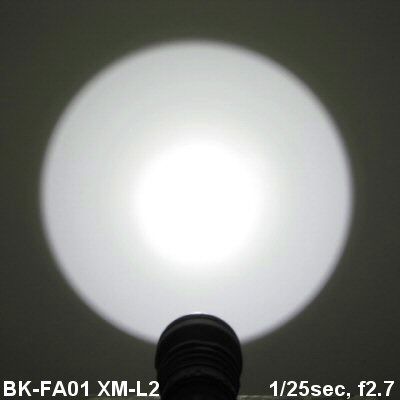
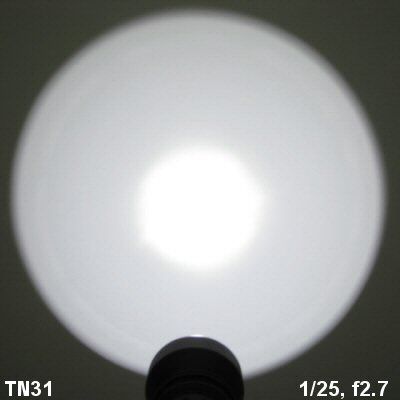
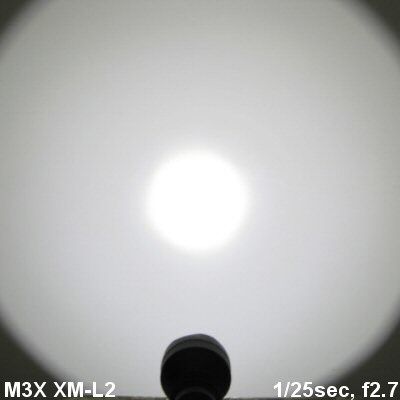
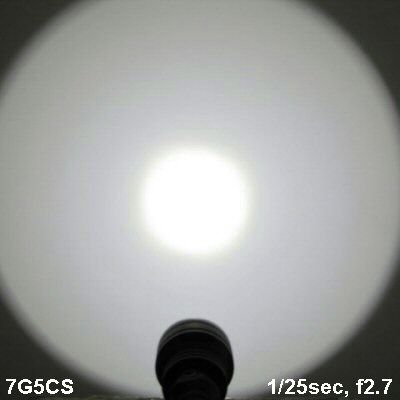
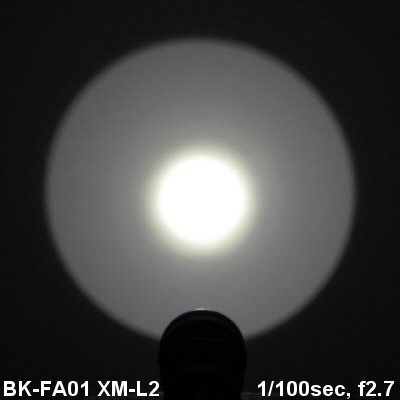
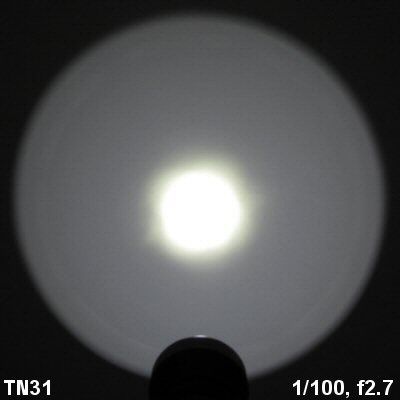
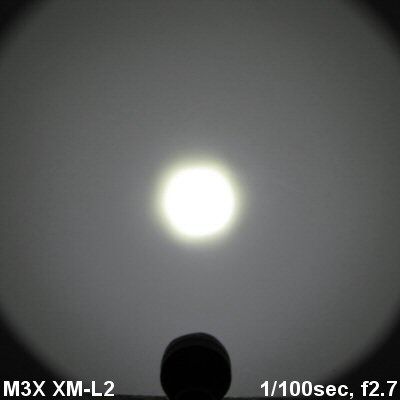
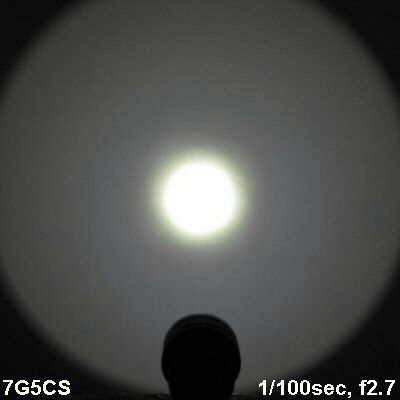
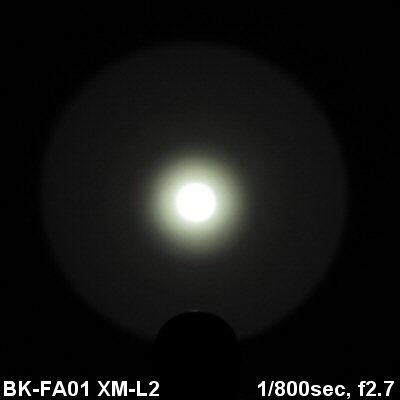
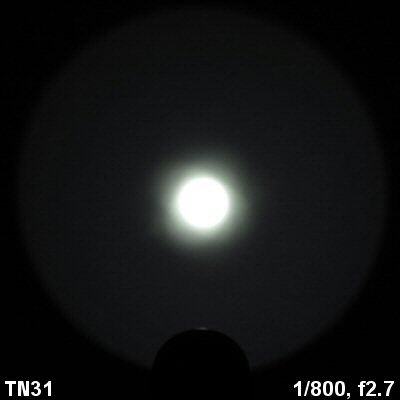
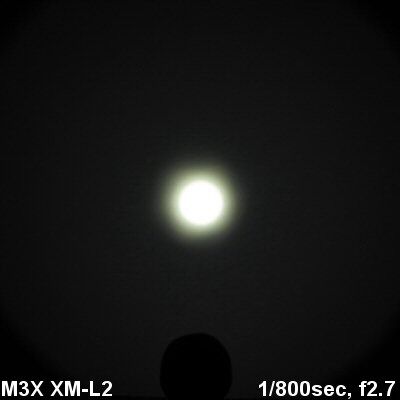
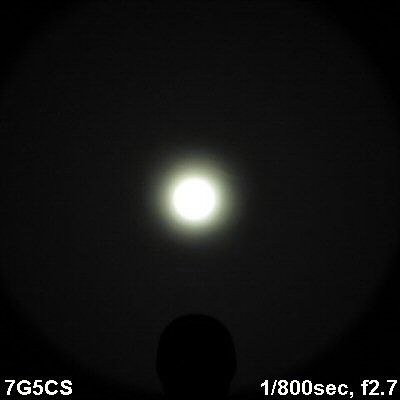
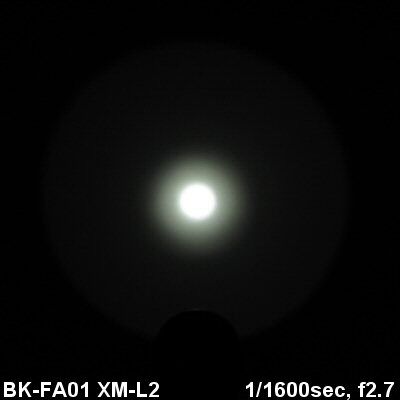
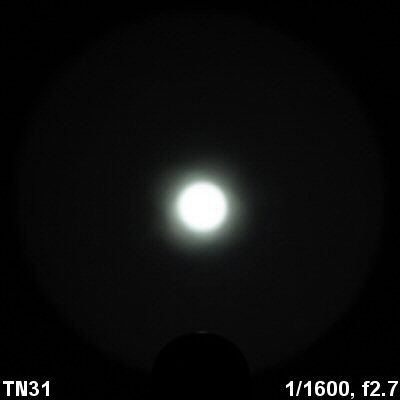
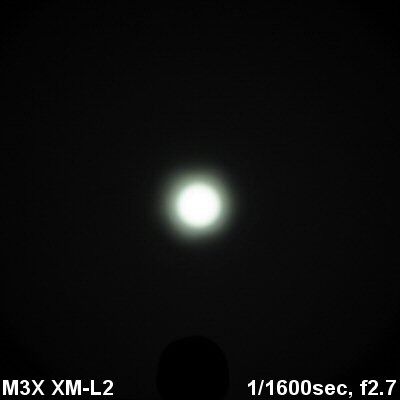
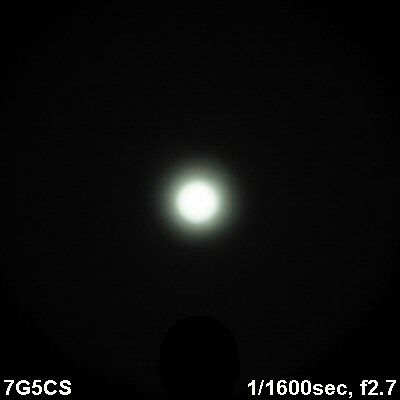
The BK-FA01 has a narrower spillbeam than most lights in the ultra-thrower category. It also has a more tightly focused hotspot that is smaller than any other light I've seen in this class oo: (although there is a reasonable size corona around that hotspot).
oo: (although there is a reasonable size corona around that hotspot).
Throw is obviously excellent – scroll down for my detailed comparison tables where I have directly measured it with a NIST-certified light meter.
BK-FA02
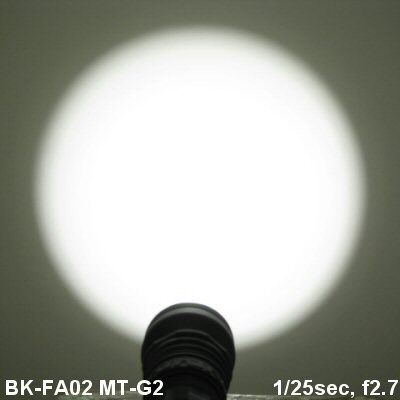
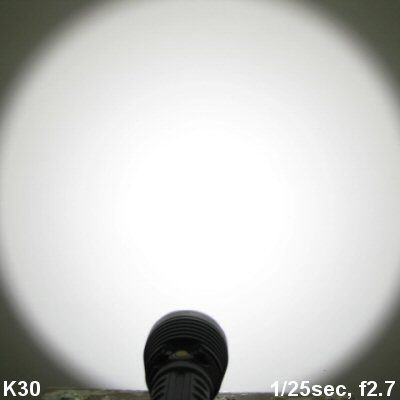
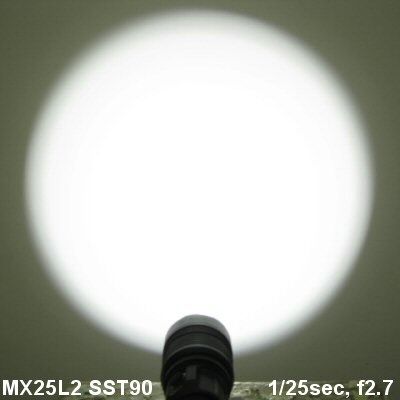
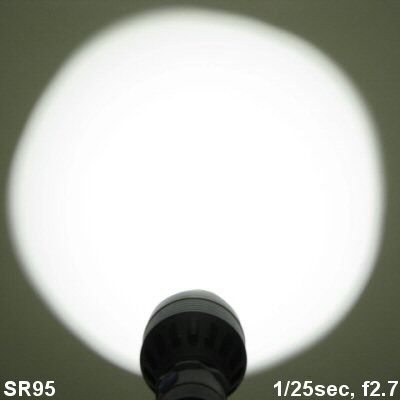
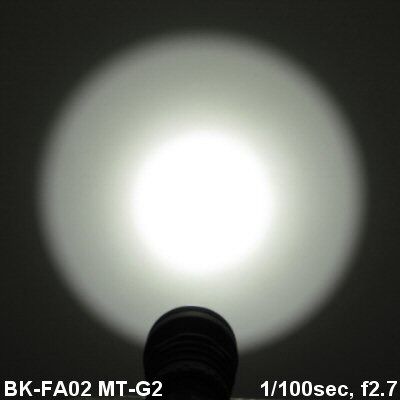
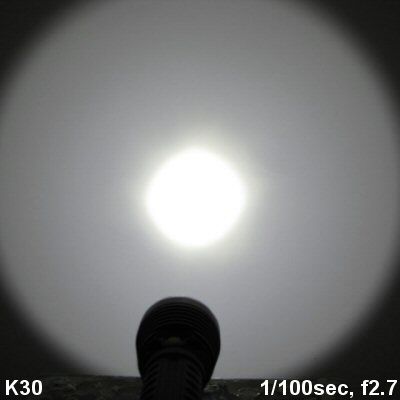
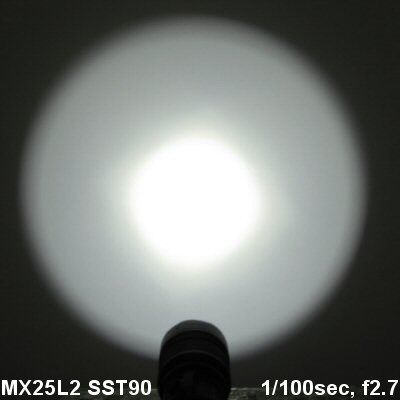
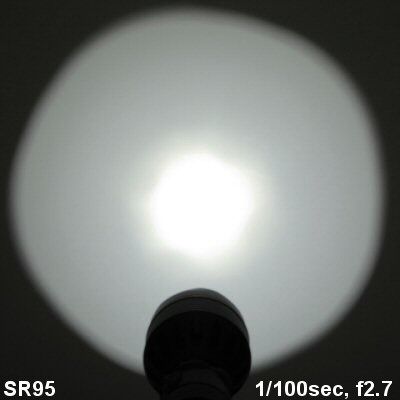
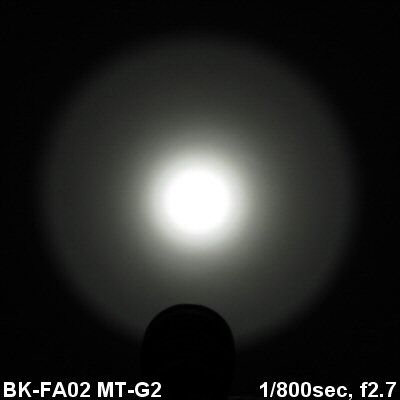
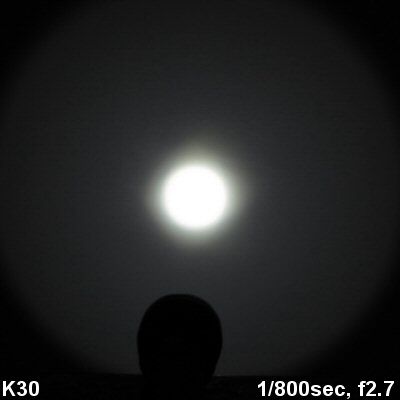
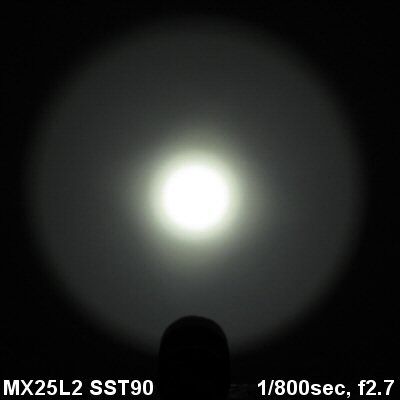
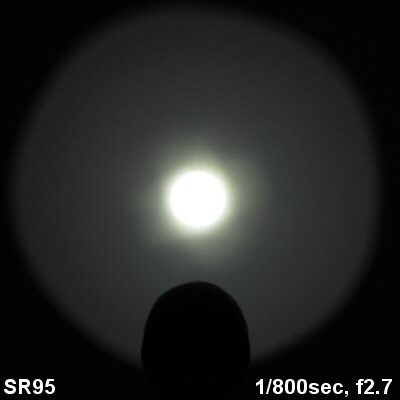
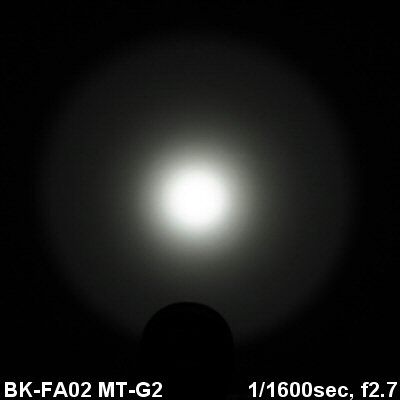

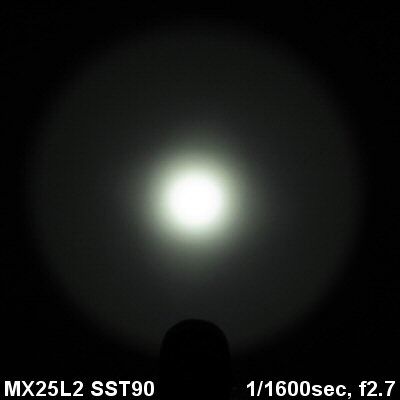
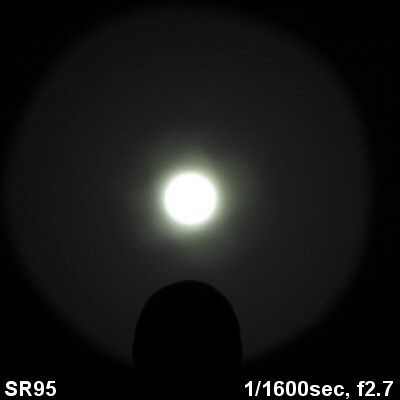
Note: Automatic color balance is used in all these beam shots, to minimize the visual effect of tint differences. In real life, the BK-FA02 is a definite Neutral White.
The BK-FA02 has an identical spillbeam width as the BK-FA01, but the pattern of the beam is quite different. In keeping with the large emitter, you see a broad hotspot on the BK-FA02, and a "floodier" beam (i.e., the distinction between hotspot and spill is less great than the BK-FA01).
Overall, the beam pattern reminds me of a Luminus SST-90 in a relatively smaller head (e.g., the Eagletac MX25L2). The Skilhunt K30 gives you an idea what to expect with a SST-90 emitter in a comparable sized head/reflector. Clearly, the MT-G2 emitter is not designed for heavy throw applications.
Here are some indoor shots, to allow you to compare the throw and spill of the three lights. For your reference, the back of the couch is about 7 feet away (~2.3m) from the opening of the light, and the far wall is about 18 feet away (~5.9m). Below I am showing a series of exposures, to allow you to better compare hotspot and spill.
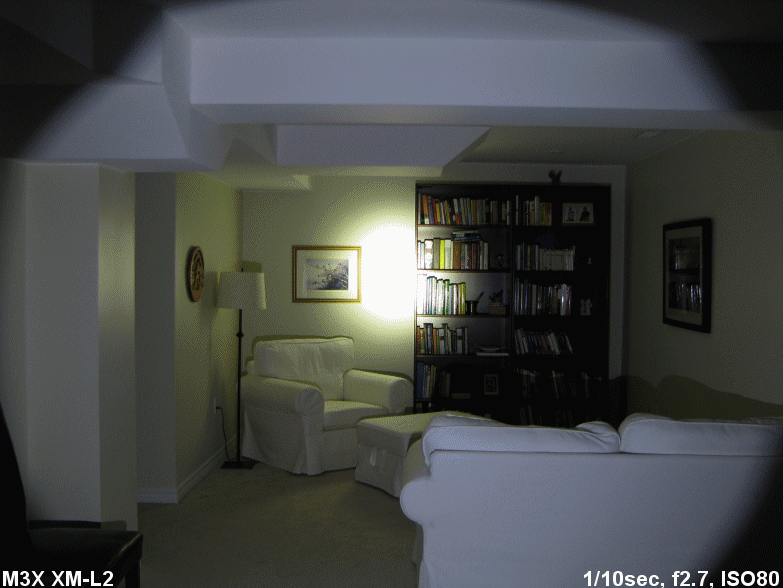
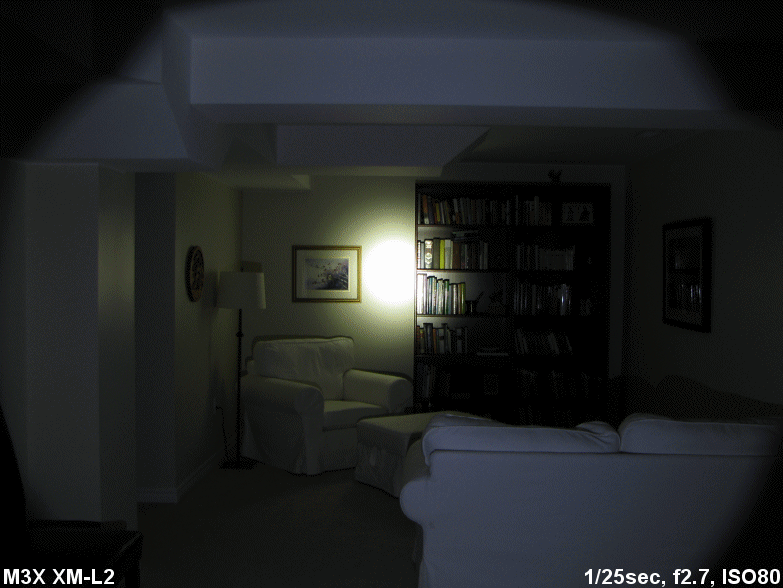
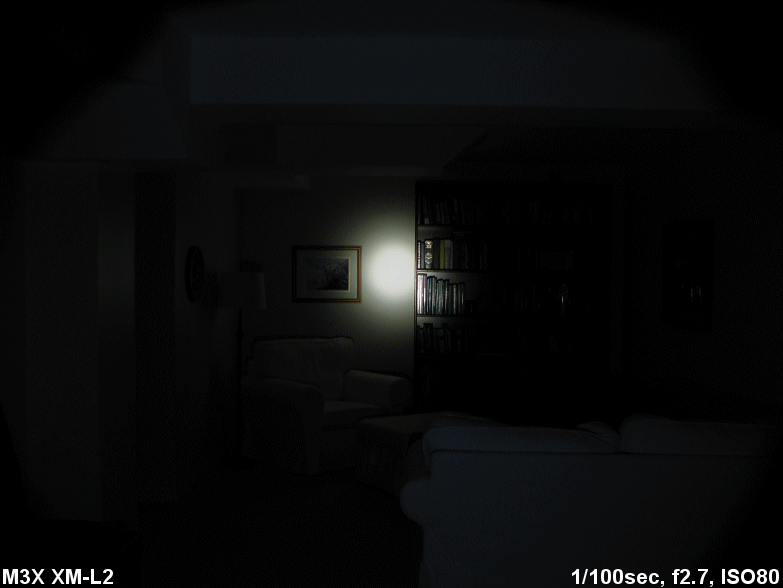
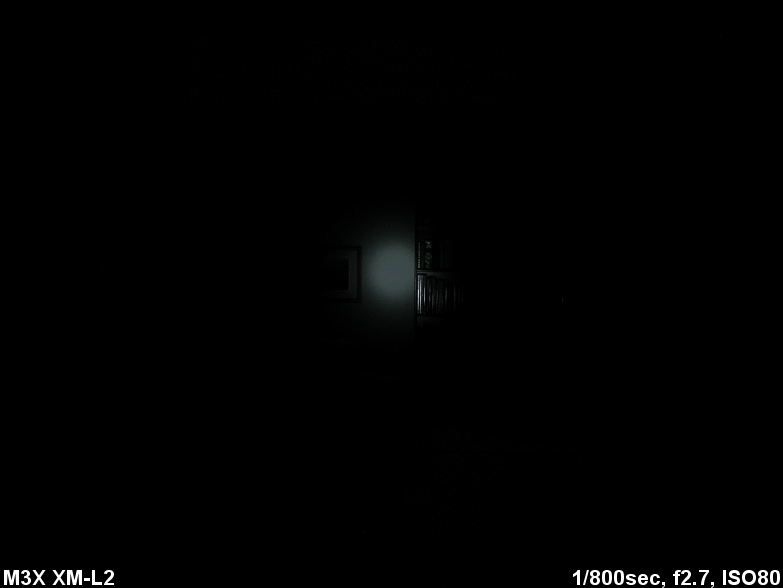
As you can see above, the BK-FA01 has the most focused hotspot I've tested in this class. Not surprisingly, it is the current reflector-based leader in throw, among my collection.
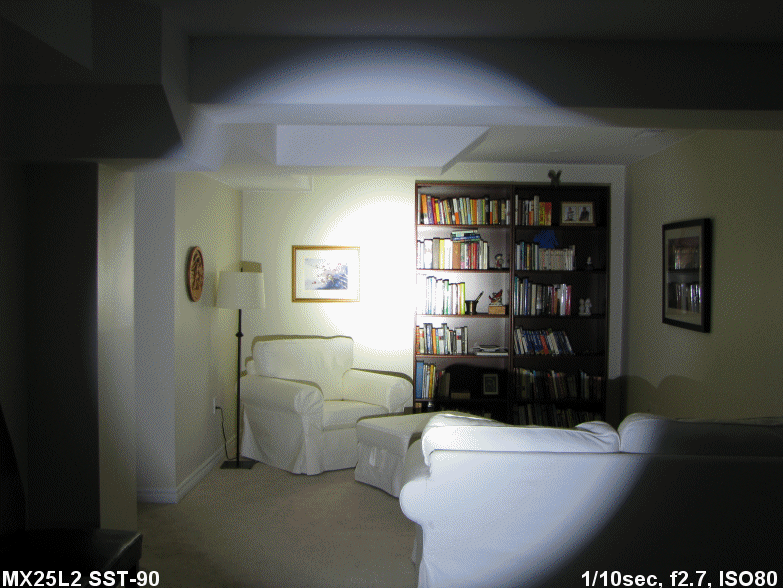
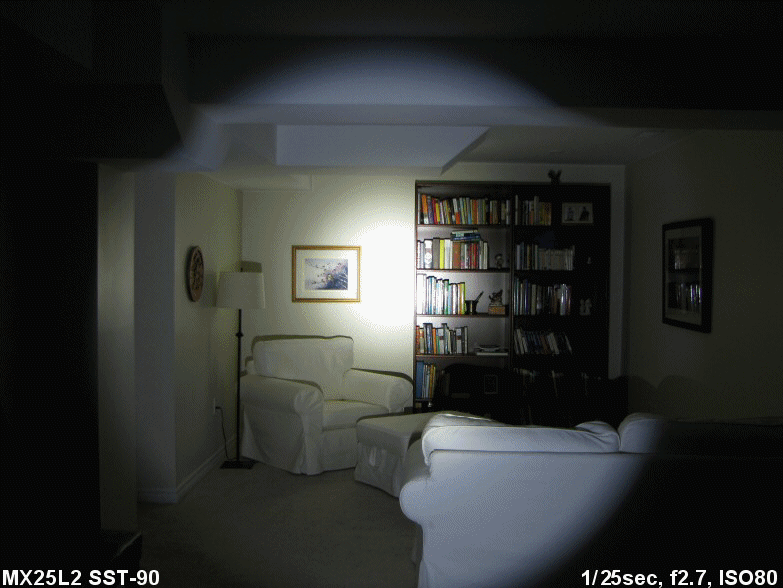
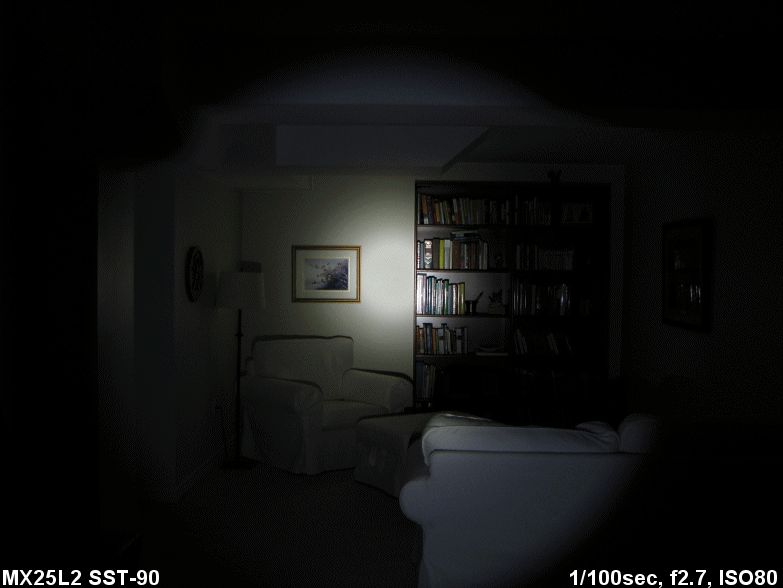
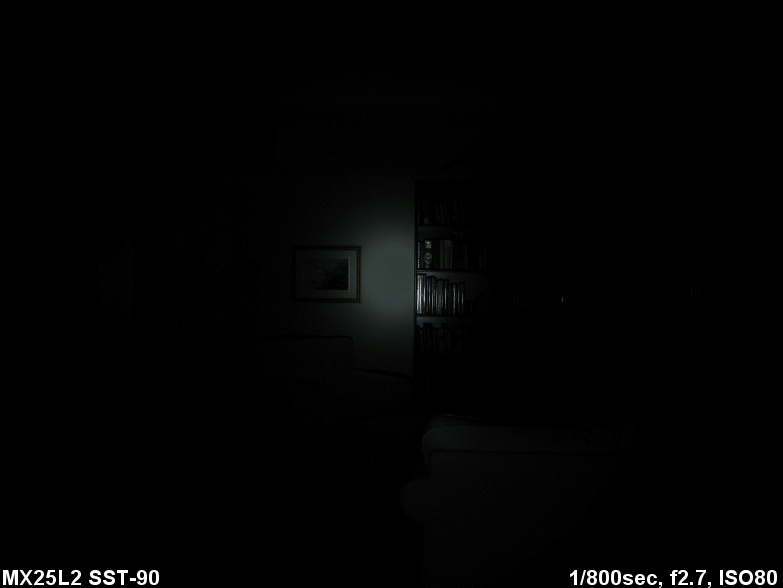
As previously noted, the larger-die MT-G2 – coupled with the deep reflector of the BK-FA02 – gives a beam pattern very similar to the SST-90-equipped Eagletac MX25L2 (standard head). And again, beam tint above is not representational, due to auto-color correction. In real life, the BK-FA02 is a relative warm Neutral White (in comparison to the Cool White SST-90s).
For outdoor beamshots, these are all done in the style of my earlier 100-yard round-up review. Please see that thread for a discussion of the topography (i.e. the road dips in the distance, to better show you the corona in the mid-ground).
FYI, any "streaks" you see across the images are bug-trails. Flying insects are often attracted to the bright lights, and their flight trails get captured as swirly streaks due to the long exposure time. Also, ignore any tint differences below – they are mainly due to the automatic white balance setting on the camera.
Also, ignore any tint differences below – they are mainly due to the automatic white balance setting on the camera.
Let's compare the two – starting with wide-angle shots, and then close-ups on the hotspots:
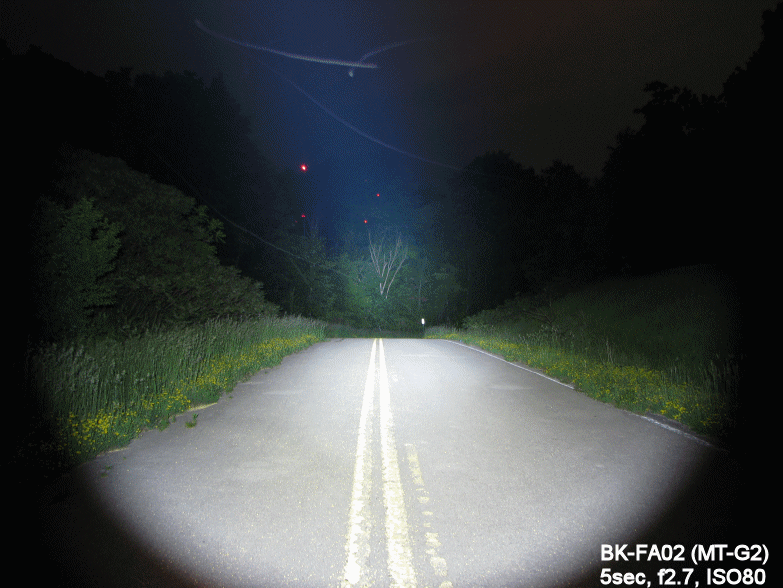
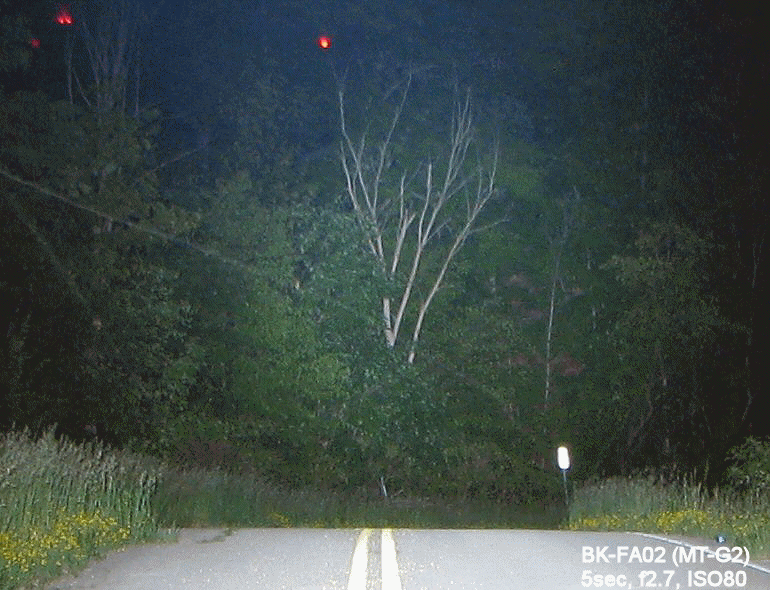
Obviously, the BK-FA02 has a lot more output than the BK-FA01 – but the BK-FA01 is far more focused for throw. To really put that in context, let's examine each relative to other lights in the same class, starting with the BK-FA01 (XM-L2):
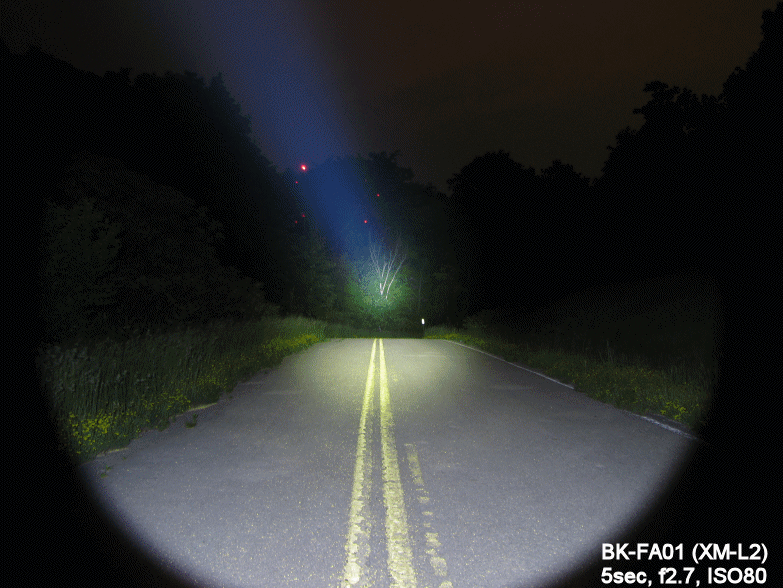

As the wide-angle shots show, the BK-FA01 has a smaller hotspot than the Thrunite TN31 or Eagletac SX25L2 Turbo (i.e., more focused for throw). Output is pretty comparable to the TN31, but the close-up shots are a little misleading here – due to the smaller hotspot on the BK-FA01, the close-up may seem dimmer (since it is restricted to just the hotspot/corona, and doesn't show all the light in the spill).
And now the BK-FA02:
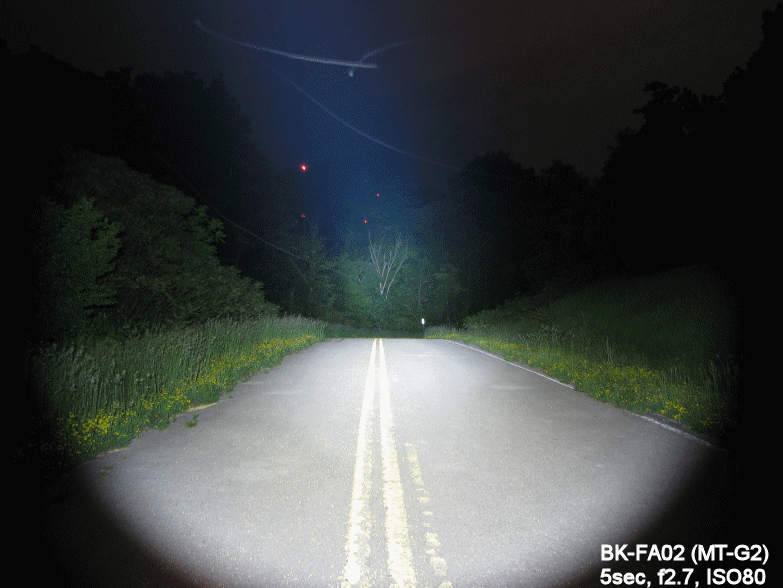

As you can see above, the main difference between the BK-FA02 and Crelant 7G10 is in the spillbeam width and intensity.
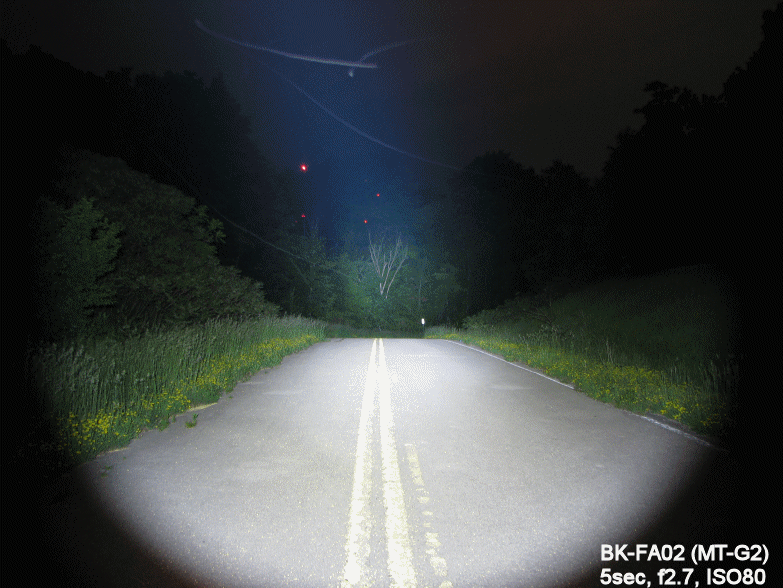
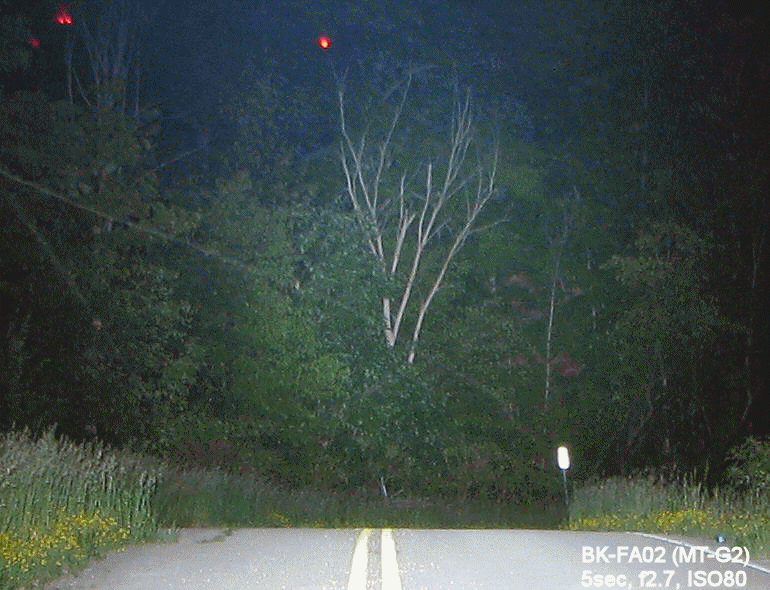
The BK-FA02 is a good comparable for multiple-emitter lights – but with a narrower and smoother spillbeam (i.e., free of artifacts). The BK-FA02 has greater throw than the Thrunite TN30, but not as great as the Fenix TK75.
The BK-FA02 has greater throw than the Thrunite TN30, but not as great as the Fenix TK75.
Testing Method:
All my output numbers are relative for my home-made light box setup, as described on my flashlightreviews.ca website. You can directly compare all my relative output values from different reviews - i.e. an output value of "10" in one graph is the same as "10" in another. All runtimes are done under a cooling fan, except for any extended run Lo/Min modes (i.e. >12 hours) which are done without cooling.
I have devised a method for converting my lightbox relative output values (ROV) to estimated Lumens. See my How to convert Selfbuilt's Lightbox values to Lumens thread for more info.
Throw/Output Summary Chart:
My summary tables are reported in a manner consistent with the ANSI FL-1 standard for flashlight testing. Please see http://www.flashlightreviews.ca/FL1.htm for a discussion, and a description of all the terms used in these tables. Effective July 2012, I have updated all my Peak Intensity/Beam Distance measures with a NIST-certified Extech EA31 lightmeter (orange highlights).
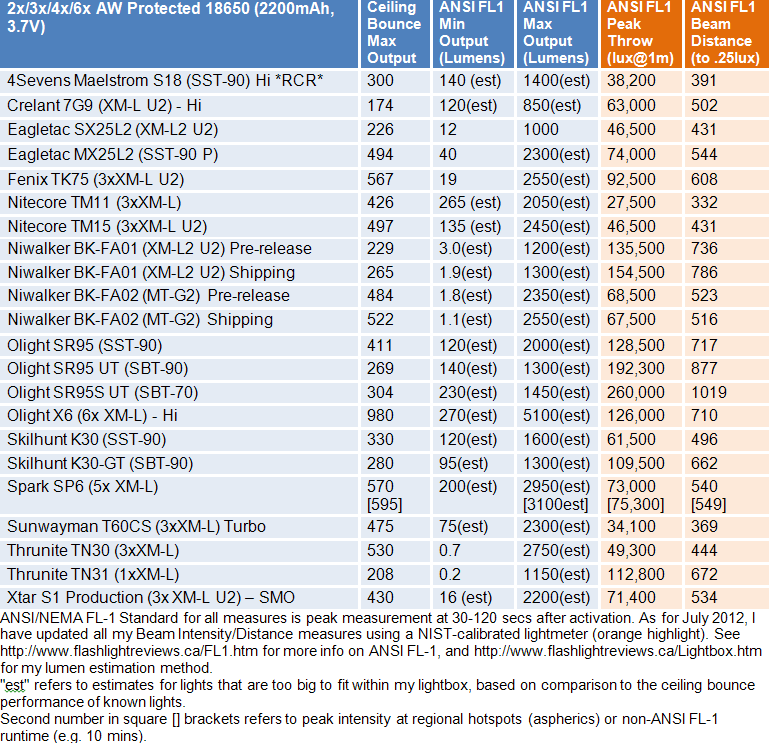
Starting with the BK-FA01, you may notice the apparent similarity in output to my XM-L-equipped Thrunite TN31. This is a little misleading, as my TN31 steps down after 3 mins whereas the BK-FA01 does not (see runtimes later in this review). I will discuss this further after the runtimes, but in practical terms over most of the run, my BK-FA01 (XM-L2 U2) seems to be ~10% brighter overall compared to TN31 (XM-L U2). This is reasonable, given that the difference between the same output bin number for XM-L2 vs XM-L is expected to be within ~8-20%. That is the statistical nature of product binning, given any emitter can fall within ~7% range of output in a given bin.
Consistent with my indoor beam shots, the larger reflector on the BK-FA01 is giving this light an advantage over the TN31 (i.e., smaller and more focused hotspot). For example, despite being only ~5% brighter overall at the ANSI FL-1 standard of 30 secs time point post-activation used above, the BK-FA01 has ~20% higher center beam throw (in cd = lux @1m equivalent).
As for the MT-G2-equipped BK-FA02, overall output is well within the range of 3xXM-L lights (or the high-end of the range of Luminus SST-90-equipped lights). Throw is certainly acceptable for the class, and again within the typical range of 3xXM-L lights. Of course, one of the nice things about a single MT-G2 emitter is that you don't have the artifacts in the beam profile produced by multiple emitters.
I don't have exact output specs from Niwalker yet, but I'll post a table after the runtimes below, summarizing my estimated outputs and runtimes for the BK-series lights. I'll update when I get more information.
UPDATE JULY 17, 2013: The shipping versions of the BK-FA01 and BK-FA02 have arrived! I have updated the summary table above with the new results. As you can see, max output has increased by ~100 lumens on the BK-FA01 and ~200 lumens on the BK-FA02. I am currently working on runtimes, and will post the results in a new thread (as there have been some build updates as well, to both the light and the carrier). Stay tuned for updates ...
Output/Runtime Graphs:

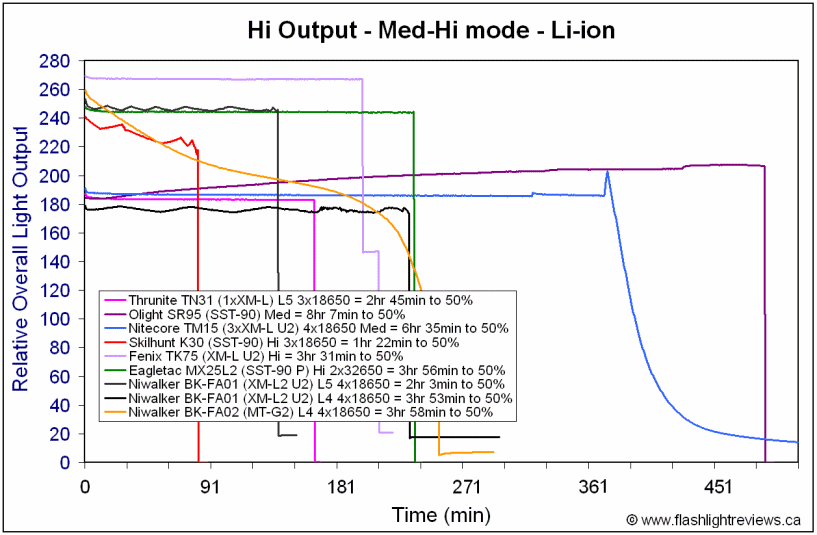
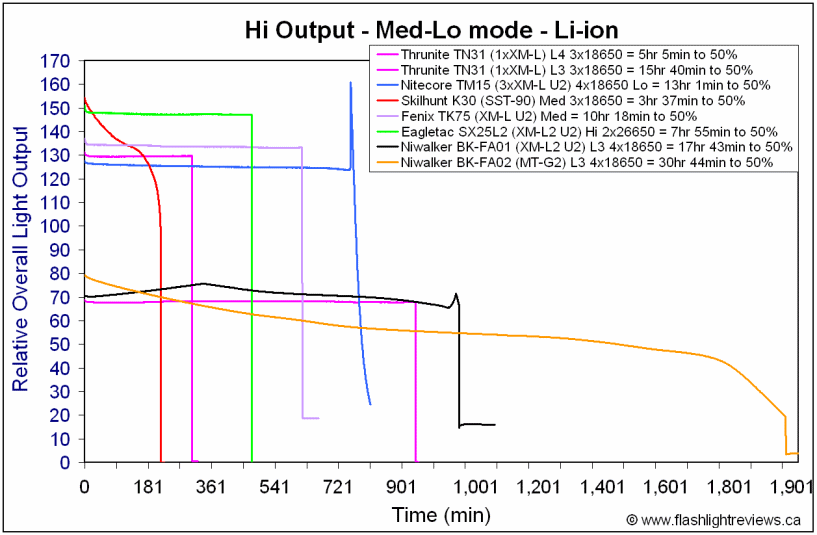
Starting with the BK-FA01, you can see pretty much what you would expect for a well-regulated light – performance very similar to the Thrunite TN31 (but with ~33% more runtime, due to the fourth 18650 cell). The main difference is that the BK-FA01 doesn't step down on L6 (max), and maintains its constant brightness for longer.
There's an interesting slow undulating pattern to the regulation on the BK-FA01 on L3-L5, but this is impossible for you to notice by eye – for all intents and purposes, the light remains perfectly flat regulated in use, until the cells are nearly exhausted – at which point, the light steps down to L2. This is a thoughtful design, as it means you are never left accidentally in the dark, without plenty of warning first. :thumbsup:
For the BK-FA02, the pattern is different – at all levels tested, you see a direct-drive-like slow decay in output. This is actually a very efficient means to control a light, but it means the light does slowly drop in in output. But again, the reduction is gradual enough that you won't notice it in practice – until you hit ~50% original output, at which point it starts to drop off more quickly. But once again though, the light drops to the L2 level, where it maintains flat regulation for a good amount of time before the cells are dead.
This pattern is not surprising to me, given the higher forward voltage of the MT-G2 LED. It's obviously going to be difficult for two 3.7V Li-ion cells (note 2s2p, so only two in series) to provide the kind of regulated power needed to keep perfectly flat regulation at all voltages.
You might have notice a somewhat unusual initial output pattern on L6 and L5 on the BK-FA02. To explore this further, here is how the light performs on both my standard 2200mAh AW protected cells and newer 3100mAh Panasonic NCR-18650A core cells, with and without cooling.
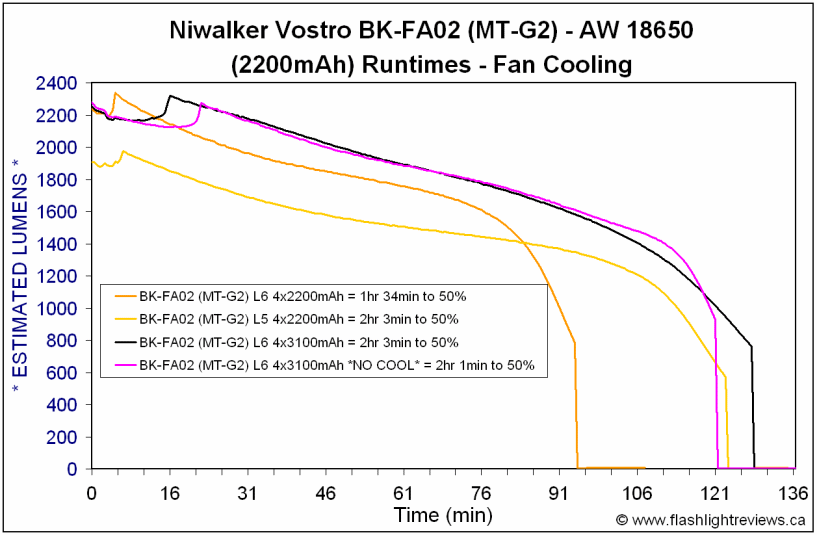
There is a variable period of time after activation (2-15 mins) before the light reaches max intensity, at least on L5 and L6. For this reason, the normal ANSI FL-1 measurement window of 30-120 sec post-activation may not always accurately capture performance. To help put that in context, I'm showing the runtimes above in my estimated lumen scale (instead of my usual simple relative lightbox output scale).
As you can see, the higher capacity 18650s cells extend the runtime by extending this initial period of relatively consistent output. But otherwise, these cells don't appreciably change the pattern of runtime. Cooling similarly doesn't have much effect either, except perhaps to shorten the initial "flat" output period.
So, let's wrap this up: :sweat:

Note that while I don't do runtimes at really low levels, I can tell you that the "tailcap" current draws for the lights at L1 and L2 were 4.1mA and 43mA for the BK-FA01, and 2.9mA and 22mAh for the BK-FA02. Given than the BK-FA01 is very tightly regulated over the run, I think you could go with reasonable estimates (for 5200mAh capacity of 4x2600mAh cells) of >50 days for L1 and ~5 days for L2. It's more complicated for the BK-FA02 because of the more efficient direct-drive-like pattern, but I would estimate on 2600mAh cells you could see something in the order of >100 days for L1, and ~14 days for L2.
Potential Issues
Due to the electronic control ring, the lights have a stand-by current when the head is fully connected to the body. I measured this at a consistent ~520~525uA, which would translate into about 14 months for standard 2600mAh 18650 cells. While reasonably low, I recommend you store the lights locked out at the head when not in use (i.e., a simple quarter turn will break the current, thanks to the anodized threads).
The control ring is fairly narrow, with greater resistance compared to most lights in this class. Actual control ring grip is ok, but it could use more differentiation from the body design. As a result, you may find it hard to consistently switch modes single-handed. A wider ring, with looser motion, would facilitate use.
While the BK-FA01 has tightly regulated performance at all levels, the BK-FA02 shows a direct-drive-like pattern at all levels. Note that direct-drive is actually more efficient, and both lights show a step-down to L2 before the batteries are exhausted. This means that you could safely use unprotected cells if you wanted, and will never be stranded without warning.
The lights appear to use PWM at some levels (most notably L4 and L5, and perhaps L3 as well) – but at a non-visually detectable 2.45 kHz. I did notice some audible hum on both my samples on L4 and L5, but it was not overly distracting.
The lights are a substantial size, with no obvious attachment points for wrist or arm straps. Accessories are unknown at the current time.
Preliminary Observations
The BK-FA01 and BK-FA02 are good additions to the high-output/thrower space. I am glad to see Niwalker has continued their tradition of extensively testing designs and circuits before release (i.e., these final engineering samples are improved over earlier models I tested).
Physically, both lights have identical builds – which are robust. With the large and deep reflector – and use of 4x18650 in a carrier arrangement – these lights carry significant heft. The reversible carrier is one of the best I've seen in this class, and it comfortably holds even the largest high-capacity protected cells I have. :thumbsup: The flip-side to that is that shorter IMR cells may be a bit loose inside the light.
The user interface is good for this class, although I'm never sure where a good place to put strobe is. My one recommendation would be to lower the control ring resistance, as the lights are currently hard to change modes single-handed. Note that Niwalker has already improved this from the early NWK1000 engineering samples, but it could still go a bit further in that regard. The lights do have clear detents at each level, so there is no risk of accidentally changing modes with the current design.
My one recommendation would be to lower the control ring resistance, as the lights are currently hard to change modes single-handed. Note that Niwalker has already improved this from the early NWK1000 engineering samples, but it could still go a bit further in that regard. The lights do have clear detents at each level, so there is no risk of accidentally changing modes with the current design.
Circuit performance was excellent at all levels tested – somewhat surprisingly so, given the high-frequency (non-visible) PWM used on levels 4 and 5. The BK-FA01 is one of the most flatly-regulated lights I've seen, and the BK-FA02 uses an efficient direct-drive-like pattern. There is one feature I really like – as the batteries near exhaustion on Levels 3-6, both lights show a step-down to the regulated Level 2 before shutting off. This means that you not will be stuck with an abrupt shut-off in typical usage – there is always plenty of warning. :twothumbs
In terms of throw, the BK-FA01 is my 3x/4x 18650 leader at the moment. Although I don't have the TN31 XM-L2 on hand to compare, I doubt it could beat it (based on the performance of my XM-L version). The larger reflector of the BK-series will likely give a consistent edge to this build, for equivalent drive level.
Although I don't have the TN31 XM-L2 on hand to compare, I doubt it could beat it (based on the performance of my XM-L version). The larger reflector of the BK-series will likely give a consistent edge to this build, for equivalent drive level.
In the terms of the BK-FA02, it is interesting to finally see a MT-G2-equipped light. I was surprised to see just how big this emitter is in real life (i.e., it makes the Luminus SST-90 seem petite). oo: But coupled with the massive reflector of the BK-series, you get decent throw in this case (i.e., similar to the smaller non-Turbo head of the SST-90-equipped Eagletac MX25L2). Output is typically higher than most SST-90 light I've tested (i.e., the BK-FA02's max output is about middle of the pack of 3xXM-L lights I've tested).
oo: But coupled with the massive reflector of the BK-series, you get decent throw in this case (i.e., similar to the smaller non-Turbo head of the SST-90-equipped Eagletac MX25L2). Output is typically higher than most SST-90 light I've tested (i.e., the BK-FA02's max output is about middle of the pack of 3xXM-L lights I've tested).
Keep in mind that the MT-G2 emitter was designed to replace directional lighting (e.g. Halogen PAR-bulbs, etc.), and so has higher voltage requirements and power output than typical LEDs for handheld devices. We'll see how other manufacturers make out in circuit design, but I expect it will be common to see direct-drive-like performance for this emitter class.
What I particularly like about MT-G2 series is the range of warm-neutral tints. :thumbsup: Niwalker labels this model as "neutral white", and this fits with my subjective impression of the last two engineering samples I've seen. I don't know if they are using a consistent tint bin, but it seems unlikely that you would get anything too cool or too warm from this emitter series.
As previously mentioned, the Black Light Vostro models from Niwalker are new options to consider in the high-output/thrower space. They have done a good job in the common design and function of the series, and in the choice of emitters.
UPDATE JULY 23, 2013: This pre-release review has been superseded by my new review of the shipping versions of these lights. Please continue all conversations in that thread, thanks!
----
BK-FA01 and BK-FA02 pre-release samples provided by Niwalker for review.
Warning: even more pic heavy than usual.
UPDATE JULY 23, 2013: This pre-release review has been superseded by my new review of the shipping versions of these lights. Please continue all conversations in that thread, thanks!

Welcome to my review of a couple of new high-output lights from Niwalker, the recently re-christened Black Light Vostro series. This series is available with either a throwy Cree XM-L2 U2, or high-output Cree MT-G2.
Model numbers are bit complicated for this series – in keeping with past Niwalker releases, I have had the opportunity to test a variety of engineering samples. Originally known as the NWK1000 series, the final pre-release samples (tested here) were known as the N4SL2 (XM-L2 U2) and N4SG2 (MT-G2), as labelled above. Niwalker plans to rename these as part of a new Black Light series (model name: Vostro). The two specific lights will be known as the BK-FA01 (XM-L2 U2) and BK-FA02 (MT-G2). Note that these were briefly referred to as "BK1" and "BK2", but I am assured by Niwalker that the BK-FA01 and BK-FA02 numbering scheme will be the final one.
As an aside, this will be my first review of a high-output light with the new Cree MT-G2 emitter. Relatively unknown in the flashlight world, the MT-G2 "Easywhite" series was designed for higher voltage, high-output directional lighting applications (i.e., as a replacement for classic halogen bulbs in accent lighting, track lights, etc.). I'll discuss the pattern of this emitter class a little later on, but I expect we will be seeing a few more lights using it in the near future, as an alternative to smaller Luminus emitters ...


At the moment, I have very limited specs from Niwalker on this series, but here's what I do have:
Manufacturer Reported Specifications:
(note: as always, these are simply what the manufacturer provides – scroll down to see my actual testing results).
- LED: Cree XM-L2 U2 Cool White (BK-FA01) and Cree MTG2 Neutral White (BK-FA02)
- Max Output : 1350 lumens (BK-FA01) and 2400 lumens (BK-FA02)
- Peak Beam Intensity: 140,500 cd (BK-FA01) and 60,500 (BK-FA02)
- Max Beam Distance/Throw: 750m (BK-FA01) and 492m (BK-FA02)
- Powered by 4x 18650 (not included)
- Body material: aluminum and magnesium
- Dimensions: Length: 208.5mm, Width (tail): 52mm, Width (bezel): 80mm
- MSRP: unknown



From left to right: AW Protected 18650; Niwalker Black Light Vostro BK-FA01, BK-FA02; Xtar S1; Skilhunt K30; Fenix TK75; Nitecore TM15.
All dimensions directly measured, and given with no batteries installed (unless indicated):
Niwalker Black Light BK-FA01: Weight: 687g (871g with 4x18650), Length: 208mm, Width (bezel): 80.0mm, Width (tailcap): 51.9mm
Niwalker Black Light BK-FA02: Weight: 689g (873g with 4x18650), Length: 208mm, Width (bezel): 80.0mm, Width (tailcap): 51.9mm
Eagletac MX25L2:Weight: 468.7g (with battery pack: 744.2g), Length: 266mm, Width (bezel): 62.0mm
Foursevens S18: Weight: 700g (800g with 6xCR123A), Length: 233mm, Width (bezel) 63.0mm
Fenix TK75: Weight: 516.0g (700g with 4x18650), Length: 184mm, Width (bezel): 87.5mm
Olight SR95: Weight: 1,224g (with battery pack), Length: 323mm, Width (bezel): 87mm
Skilhunt K30: Weight: 636.0g (773g with 3x18650), Length: 199m, Width (bezel): 76.0mm
Thrunite TN31: Weight: 572g (est 724g with 3x18650), Length: 203mm, Width (bezel): 79.0mm, Width (tailcap): 49.0mm
Xtar S1 Production: Weight: 876.0g (est. 1028g with 3x18650 protected), Length: 240mm, Width (bezel): 83.4mm
The BK-FA0x series has a substantial form factor, in keeping with other 3x and 4x18650 lights in this space.







Keep in mind that my samples are the last round of engineering samples, and things could potentially still change when the shipping versions roll out. The most obvious change should be in the body labels – the N4SL2 and N4SG2 will be renamed BK-FA01 and BK-FA02, according to Niwalker.
Both my samples came with serial numbers, and all lettering was bright white and clear against the dark background. The lights come in a matte black finish. There were a few chips in some locations on my samples, but that may just reflect their engineering sample status (i.e., they underwent specific testing before being sent to me, and had the chance to get banged up a bit).
As mentioned earlier, over size is substantial. They remind me of the Thrunite TN31 in rough dimensions, but the battery handle is of course slightly wider to accommodate four cells instead of three (with concomitant weight increase). Like the TN31, there is knurling on the body handle to help with grip, and some ridge detail on the head and ring. Grip is certainly ok, and comparable to the TN31.
One difference is that I find the control ring to be a bit "stiffer" overall than on the TN31. Both my BK-series had more resistance to turning, which could make changing modes single-hand tougher for those without decent grip strength. Note the control ring is much narrower than the TN31, contributing to this challenge (i.e., there is less for your fingers to grip onto). :shrug: But like the TN31, there are firm and clear detents for each level (see User Interface for a discussion of the modes).
The lights can tailstand stably, thanks to the flat base.
Screw threads are anodized for head lock out, and feature square-cut (trapezoidal) threads. :thumbsup:
There is a central contact point in the center of the head of the light, which has a spring underneath. This makes contact with the recessed inner positive terminal of the battery carrier. The negative current path is carried from the outside part of the battery carrier, carried through a spring in the tailcap through the body of the light.
Battery carrier:




The carrier has a very solid feel, with thick end plates and sturdy struts. The carrier has a 2s2p arrangement (i.e., two cells in parallel, two channels in series). This means in theory that you could run the light on just two cells if necessary, but I wouldn't recommend this on the higher output modes (unless using IMR chemistry which can handle the higher current drain). The carriers are reversible – they fit and work in the light in either orientation.
Often, on other lights, I find battery carriers to be a tight fit for cells, not allowing really long or wide cells into the carrier/light (a particular issue for the newer high capacity cells on the market). Some also have physical reverse polarity protectors around the positive terminals (preventing use of flat-top cells). I'm happy to report the BK-series carrier has plenty of room for everything I own, and the raised positive contact posts work with all cell types (including flat-tops). :thumbsup:
Let's see how the business ends of the lights differ:
BK-FA01 head:



BK-FA02 head:



Clearly, the BK-series is using a large reflector – it's one of the deepest ones I've seen, in fact.
In both cases, the emitters were well centered in their reflectors. The XM-L2 emitter is probably already very familiar to the members here, but the MT-G2 is an interesting choice to find in a flashlight. According the Cree MT-G2 spec sheet, the emphasis for this series is "down lighting applications where color quality, consistency and optical control are required."
As you can tell, the MT-G2 is a remarkably large emitter, with a dome diameter of almost 8.9mm (vs. 5mm on the XM-L2). Of course, what really matters is the surface area of the die underneath, which is only 2x2mm on the XM-L2. I am not sure of the actual die dimensions on the MT-G2, but as you will see in the blow-up pics below (same magnification), there appears to be a grid of 72 distinct segments.
XM-L2:

MT-G2:

The result of this will be reduced throw for a given output level, compared to even the relatively large Luminus SST-90. The MT-G2 is also an unusual choice for a flashlight as it runs at much higher forward voltages (6V, 9V or 36V, depending on the model), compared to the <3V typical flashlight LED. All told, the MT-G2 is something I would expect to see in a LED replacement bulb for a standard PAR20 halogen pot light, or BR30 halogen flood light, for example.
The MT-G2 also comes in a wide variety of relatively warm defined tint bins – 2700K, 3000K, 3500K, 4000K, and 5000K color temperature – with a minimum CRI of 70-75, depending on the tint bin. Cree also offers higher 80 CRI at the cooler end of the tint bins, and guaranteed 90 CRI at the warmer end of the tint bins (presumably for increased cost).
I don't know if a defined tint bin is used in the BK-FA02, but Niwalker reports this model to be "Neutral White". That is consistent with the samples I've tested, which I would consider to be around the middle of the above range offered by Cree.
User Interface
The BK-series lights use a magnetic control ring, very similar in function to the Thrnunite TN30/31. But as previously mentioned, the ring has a narrower height on the BK-series, and my two samples both show higher resistance to turning. Like the TN30/31, the ring does have pronounced detents at each position (i.e., you can feel when the light "locks" into position for a given mode).
You turn on or change output modes by turning the control ring. Arranged from left-to-right (looking down at the light, held in traditional forward flashlight carry), the modes are: Strobe > Standby Off > Level 1 > Level 2 > Level 3 > Level 4 > Level 5 > Level 6 (max). See my testing results later in this review for the relative output mode spacing.
I've seen similar spacings on small hand-held lights (i.e., Strobe being located to the left of Standby/Off). But most manufacturers tend to put any blinky modes at the end of the sequence, by the highest output.
No light is produced on Standby/Off, but a small current will be drawn to allow the circuit to respond to a ring turn (see below). As always, I recommend you store such lights locked-out by a head twist.
Video:
For more information on the overall build and user interface of the BK-series, please see my video overview:
Videos were recorded in 720p, but YouTube typically defaults to 360p. Once the video is running, you can click on the configuration settings icon and select the higher 480p to 720p options. You can also run full-screen.
As with all my videos, I recommend you have annotations turned on. I commonly update the commentary with additional information or clarifications before publicly releasing the video.
PWM/Strobe
The BK-FA01 and BK-FA02 show completely identical circuit patterns at all levels. The lights appear to use high-frequency PWM that is not visible to the eye: 2.45 kHz.
However, it is a little more complicated than that. At the three lowest levels, the lights have a re-occurring signal at this 2.45 kHz frequency – but without the typical PWM pattern, as shown below.
Level 1

Level 2

Level 3

As you can see above, you just get a simple spike at this frequency on these three lowest levels. The intensity of the signal seems directly proportional to the output level, and there is no sign of the classic PWM pattern (i.e., the on-phase should be getting longer as you go up in output). On the basis of this result, I would think these levels are current-controlled, but with a recurrent 2.45kHz signal.
In contrast, the next two levels clearly show a typical PWM profile, at the same frequency:
Level 4

Level 5

Here you can see the typical PWM pattern – at Level 4, the light is on ~45% of the time, and level 5 the light is on ~80% of the time. This is exactly what you would expect, based on my estimated output measures (see later in the review).
Note that at Level 6, there is no signal at all – the light is at full uninterrupted power.
Based on these findings, I would tentatively conclude that these lights use PWM for L4 and L5 (and maybe L3), but are in fact current-controlled at L1 and L2 (and maybe L3) with a recurrent signal.
Strobe

Strobe is a consistent 10Hz in my testing, on both lights.
Standby Drain
Due to the electronic control ring, the BK-series lights will always be drawing a current when the body/carrier is connected to the head. On the BK-FA01 I measured this current as 525uA, and on the BK-FA02 I measured it as 520uA.
Assuming 4x 2600mAh capacity batteries in the 2s2p arrangement (i.e., 5200mAh effective capacity), that would give you ~415 days for each of the lights (or just under 14 months). This is not unreasonable for this type of light, but I do recommend you store the lights with the head locked out when not in use. This just requires a quick turn from fully tight, as the screw threads are anodized for lock out.
Beamshots:
And now, what you have all been waiting for.
BK-FA01
















The BK-FA01 has a narrower spillbeam than most lights in the ultra-thrower category. It also has a more tightly focused hotspot that is smaller than any other light I've seen in this class
Throw is obviously excellent – scroll down for my detailed comparison tables where I have directly measured it with a NIST-certified light meter.
BK-FA02
















Note: Automatic color balance is used in all these beam shots, to minimize the visual effect of tint differences. In real life, the BK-FA02 is a definite Neutral White.
The BK-FA02 has an identical spillbeam width as the BK-FA01, but the pattern of the beam is quite different. In keeping with the large emitter, you see a broad hotspot on the BK-FA02, and a "floodier" beam (i.e., the distinction between hotspot and spill is less great than the BK-FA01).
Overall, the beam pattern reminds me of a Luminus SST-90 in a relatively smaller head (e.g., the Eagletac MX25L2). The Skilhunt K30 gives you an idea what to expect with a SST-90 emitter in a comparable sized head/reflector. Clearly, the MT-G2 emitter is not designed for heavy throw applications.
Here are some indoor shots, to allow you to compare the throw and spill of the three lights. For your reference, the back of the couch is about 7 feet away (~2.3m) from the opening of the light, and the far wall is about 18 feet away (~5.9m). Below I am showing a series of exposures, to allow you to better compare hotspot and spill.




As you can see above, the BK-FA01 has the most focused hotspot I've tested in this class. Not surprisingly, it is the current reflector-based leader in throw, among my collection.




As previously noted, the larger-die MT-G2 – coupled with the deep reflector of the BK-FA02 – gives a beam pattern very similar to the SST-90-equipped Eagletac MX25L2 (standard head). And again, beam tint above is not representational, due to auto-color correction. In real life, the BK-FA02 is a relative warm Neutral White (in comparison to the Cool White SST-90s).
For outdoor beamshots, these are all done in the style of my earlier 100-yard round-up review. Please see that thread for a discussion of the topography (i.e. the road dips in the distance, to better show you the corona in the mid-ground).
FYI, any "streaks" you see across the images are bug-trails. Flying insects are often attracted to the bright lights, and their flight trails get captured as swirly streaks due to the long exposure time.
Let's compare the two – starting with wide-angle shots, and then close-ups on the hotspots:


Obviously, the BK-FA02 has a lot more output than the BK-FA01 – but the BK-FA01 is far more focused for throw. To really put that in context, let's examine each relative to other lights in the same class, starting with the BK-FA01 (XM-L2):


As the wide-angle shots show, the BK-FA01 has a smaller hotspot than the Thrunite TN31 or Eagletac SX25L2 Turbo (i.e., more focused for throw). Output is pretty comparable to the TN31, but the close-up shots are a little misleading here – due to the smaller hotspot on the BK-FA01, the close-up may seem dimmer (since it is restricted to just the hotspot/corona, and doesn't show all the light in the spill).
And now the BK-FA02:


As you can see above, the main difference between the BK-FA02 and Crelant 7G10 is in the spillbeam width and intensity.


The BK-FA02 is a good comparable for multiple-emitter lights – but with a narrower and smoother spillbeam (i.e., free of artifacts).
Testing Method:
All my output numbers are relative for my home-made light box setup, as described on my flashlightreviews.ca website. You can directly compare all my relative output values from different reviews - i.e. an output value of "10" in one graph is the same as "10" in another. All runtimes are done under a cooling fan, except for any extended run Lo/Min modes (i.e. >12 hours) which are done without cooling.
I have devised a method for converting my lightbox relative output values (ROV) to estimated Lumens. See my How to convert Selfbuilt's Lightbox values to Lumens thread for more info.
Throw/Output Summary Chart:
My summary tables are reported in a manner consistent with the ANSI FL-1 standard for flashlight testing. Please see http://www.flashlightreviews.ca/FL1.htm for a discussion, and a description of all the terms used in these tables. Effective July 2012, I have updated all my Peak Intensity/Beam Distance measures with a NIST-certified Extech EA31 lightmeter (orange highlights).

Starting with the BK-FA01, you may notice the apparent similarity in output to my XM-L-equipped Thrunite TN31. This is a little misleading, as my TN31 steps down after 3 mins whereas the BK-FA01 does not (see runtimes later in this review). I will discuss this further after the runtimes, but in practical terms over most of the run, my BK-FA01 (XM-L2 U2) seems to be ~10% brighter overall compared to TN31 (XM-L U2). This is reasonable, given that the difference between the same output bin number for XM-L2 vs XM-L is expected to be within ~8-20%. That is the statistical nature of product binning, given any emitter can fall within ~7% range of output in a given bin.
Consistent with my indoor beam shots, the larger reflector on the BK-FA01 is giving this light an advantage over the TN31 (i.e., smaller and more focused hotspot). For example, despite being only ~5% brighter overall at the ANSI FL-1 standard of 30 secs time point post-activation used above, the BK-FA01 has ~20% higher center beam throw (in cd = lux @1m equivalent).
As for the MT-G2-equipped BK-FA02, overall output is well within the range of 3xXM-L lights (or the high-end of the range of Luminus SST-90-equipped lights). Throw is certainly acceptable for the class, and again within the typical range of 3xXM-L lights. Of course, one of the nice things about a single MT-G2 emitter is that you don't have the artifacts in the beam profile produced by multiple emitters.
I don't have exact output specs from Niwalker yet, but I'll post a table after the runtimes below, summarizing my estimated outputs and runtimes for the BK-series lights. I'll update when I get more information.
UPDATE JULY 17, 2013: The shipping versions of the BK-FA01 and BK-FA02 have arrived! I have updated the summary table above with the new results. As you can see, max output has increased by ~100 lumens on the BK-FA01 and ~200 lumens on the BK-FA02. I am currently working on runtimes, and will post the results in a new thread (as there have been some build updates as well, to both the light and the carrier). Stay tuned for updates ...
Output/Runtime Graphs:



Starting with the BK-FA01, you can see pretty much what you would expect for a well-regulated light – performance very similar to the Thrunite TN31 (but with ~33% more runtime, due to the fourth 18650 cell). The main difference is that the BK-FA01 doesn't step down on L6 (max), and maintains its constant brightness for longer.
There's an interesting slow undulating pattern to the regulation on the BK-FA01 on L3-L5, but this is impossible for you to notice by eye – for all intents and purposes, the light remains perfectly flat regulated in use, until the cells are nearly exhausted – at which point, the light steps down to L2. This is a thoughtful design, as it means you are never left accidentally in the dark, without plenty of warning first. :thumbsup:
For the BK-FA02, the pattern is different – at all levels tested, you see a direct-drive-like slow decay in output. This is actually a very efficient means to control a light, but it means the light does slowly drop in in output. But again, the reduction is gradual enough that you won't notice it in practice – until you hit ~50% original output, at which point it starts to drop off more quickly. But once again though, the light drops to the L2 level, where it maintains flat regulation for a good amount of time before the cells are dead.
This pattern is not surprising to me, given the higher forward voltage of the MT-G2 LED. It's obviously going to be difficult for two 3.7V Li-ion cells (note 2s2p, so only two in series) to provide the kind of regulated power needed to keep perfectly flat regulation at all voltages.
You might have notice a somewhat unusual initial output pattern on L6 and L5 on the BK-FA02. To explore this further, here is how the light performs on both my standard 2200mAh AW protected cells and newer 3100mAh Panasonic NCR-18650A core cells, with and without cooling.

There is a variable period of time after activation (2-15 mins) before the light reaches max intensity, at least on L5 and L6. For this reason, the normal ANSI FL-1 measurement window of 30-120 sec post-activation may not always accurately capture performance. To help put that in context, I'm showing the runtimes above in my estimated lumen scale (instead of my usual simple relative lightbox output scale).
As you can see, the higher capacity 18650s cells extend the runtime by extending this initial period of relatively consistent output. But otherwise, these cells don't appreciably change the pattern of runtime. Cooling similarly doesn't have much effect either, except perhaps to shorten the initial "flat" output period.
So, let's wrap this up: :sweat:

Note that while I don't do runtimes at really low levels, I can tell you that the "tailcap" current draws for the lights at L1 and L2 were 4.1mA and 43mA for the BK-FA01, and 2.9mA and 22mAh for the BK-FA02. Given than the BK-FA01 is very tightly regulated over the run, I think you could go with reasonable estimates (for 5200mAh capacity of 4x2600mAh cells) of >50 days for L1 and ~5 days for L2. It's more complicated for the BK-FA02 because of the more efficient direct-drive-like pattern, but I would estimate on 2600mAh cells you could see something in the order of >100 days for L1, and ~14 days for L2.
Potential Issues
Due to the electronic control ring, the lights have a stand-by current when the head is fully connected to the body. I measured this at a consistent ~520~525uA, which would translate into about 14 months for standard 2600mAh 18650 cells. While reasonably low, I recommend you store the lights locked out at the head when not in use (i.e., a simple quarter turn will break the current, thanks to the anodized threads).
The control ring is fairly narrow, with greater resistance compared to most lights in this class. Actual control ring grip is ok, but it could use more differentiation from the body design. As a result, you may find it hard to consistently switch modes single-handed. A wider ring, with looser motion, would facilitate use.
While the BK-FA01 has tightly regulated performance at all levels, the BK-FA02 shows a direct-drive-like pattern at all levels. Note that direct-drive is actually more efficient, and both lights show a step-down to L2 before the batteries are exhausted. This means that you could safely use unprotected cells if you wanted, and will never be stranded without warning.
The lights appear to use PWM at some levels (most notably L4 and L5, and perhaps L3 as well) – but at a non-visually detectable 2.45 kHz. I did notice some audible hum on both my samples on L4 and L5, but it was not overly distracting.
The lights are a substantial size, with no obvious attachment points for wrist or arm straps. Accessories are unknown at the current time.
Preliminary Observations
The BK-FA01 and BK-FA02 are good additions to the high-output/thrower space. I am glad to see Niwalker has continued their tradition of extensively testing designs and circuits before release (i.e., these final engineering samples are improved over earlier models I tested).
Physically, both lights have identical builds – which are robust. With the large and deep reflector – and use of 4x18650 in a carrier arrangement – these lights carry significant heft. The reversible carrier is one of the best I've seen in this class, and it comfortably holds even the largest high-capacity protected cells I have. :thumbsup: The flip-side to that is that shorter IMR cells may be a bit loose inside the light.
The user interface is good for this class, although I'm never sure where a good place to put strobe is.
Circuit performance was excellent at all levels tested – somewhat surprisingly so, given the high-frequency (non-visible) PWM used on levels 4 and 5. The BK-FA01 is one of the most flatly-regulated lights I've seen, and the BK-FA02 uses an efficient direct-drive-like pattern. There is one feature I really like – as the batteries near exhaustion on Levels 3-6, both lights show a step-down to the regulated Level 2 before shutting off. This means that you not will be stuck with an abrupt shut-off in typical usage – there is always plenty of warning. :twothumbs
In terms of throw, the BK-FA01 is my 3x/4x 18650 leader at the moment.
In the terms of the BK-FA02, it is interesting to finally see a MT-G2-equipped light. I was surprised to see just how big this emitter is in real life (i.e., it makes the Luminus SST-90 seem petite).
Keep in mind that the MT-G2 emitter was designed to replace directional lighting (e.g. Halogen PAR-bulbs, etc.), and so has higher voltage requirements and power output than typical LEDs for handheld devices. We'll see how other manufacturers make out in circuit design, but I expect it will be common to see direct-drive-like performance for this emitter class.
What I particularly like about MT-G2 series is the range of warm-neutral tints. :thumbsup: Niwalker labels this model as "neutral white", and this fits with my subjective impression of the last two engineering samples I've seen. I don't know if they are using a consistent tint bin, but it seems unlikely that you would get anything too cool or too warm from this emitter series.
As previously mentioned, the Black Light Vostro models from Niwalker are new options to consider in the high-output/thrower space. They have done a good job in the common design and function of the series, and in the choice of emitters.
UPDATE JULY 23, 2013: This pre-release review has been superseded by my new review of the shipping versions of these lights. Please continue all conversations in that thread, thanks!
----
BK-FA01 and BK-FA02 pre-release samples provided by Niwalker for review.
Last edited:

